#officer vince howard
Text
Hi guys,
I mentioned that for some episodes I don't have enough screenshots.
Well, I've decided to post them all but this is rare (I hope). ;-)
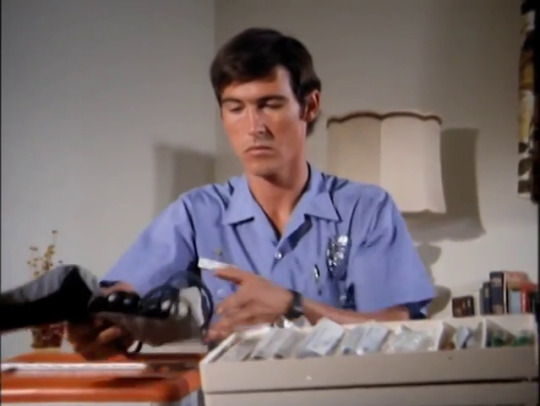




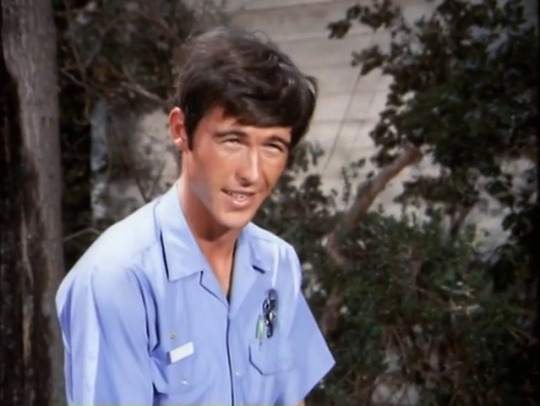




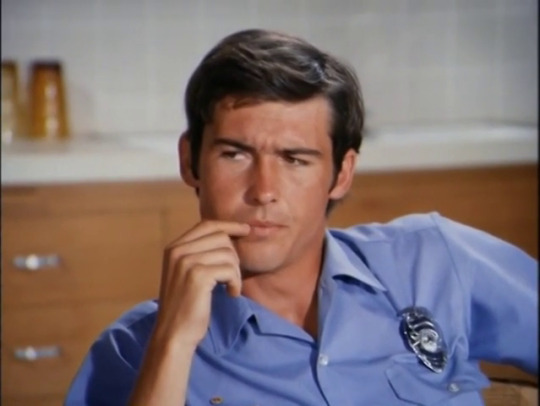
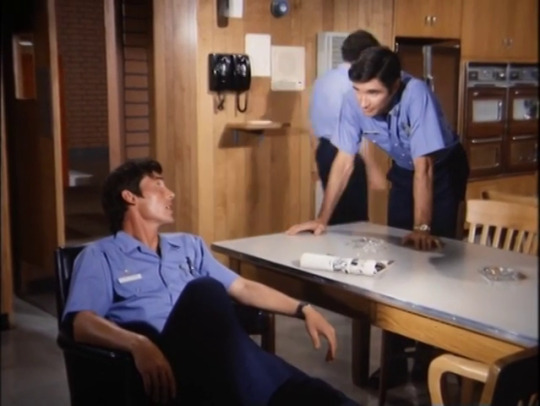

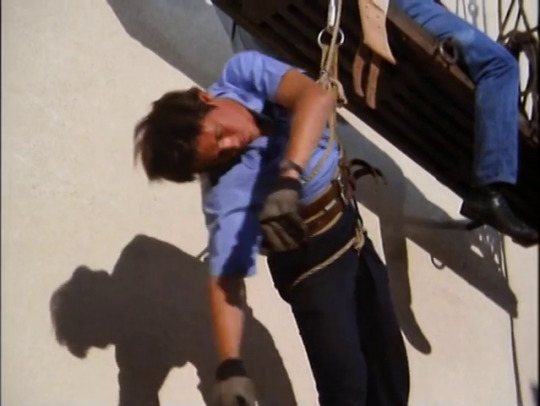
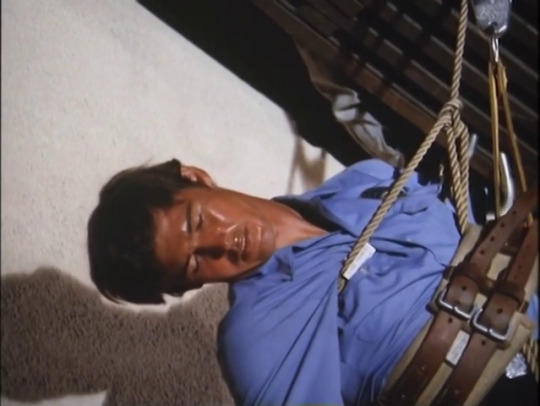

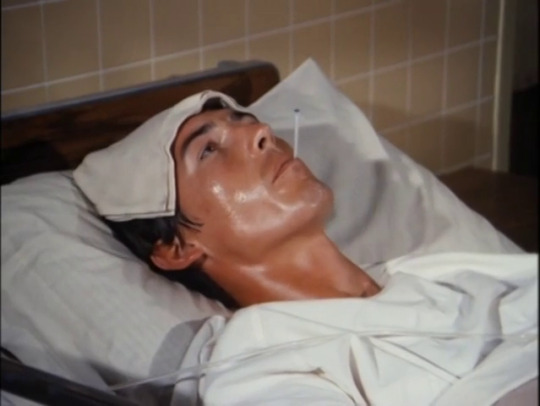



You know this episode and so I remain quiet.
As said, a rare occasion with all pics from an episode. Enjoy!!
P.S.: A Gif update should come up tomorrow.
#oldtv's e! snapshots#emergency!#s02e04#johnny gage#roy desoto#station 51#chet kelly#captain hank stanley#mike stoker#marco lopez#rampart hospital#dr. joe early#dr. kelly brackett#nurse shelly waters#officer vince howard#koki the monkey#enjoy!
12 notes
·
View notes
Text
doumekiss 2023 fanfic masterlist
A Song of Ice and Fire
When You Were Young - 3/9 - (Lyanna/Howland)
Beyond Duty - 2/2 (Stannis/Catelyn)
Switched Fates - 4/? (Multiple ships and characters)
I am ash from your fire - oneshot (Elia/Rhaegar)
runs in the family - oneshot (Daenerys)
but I'll see you in my holiest dreams - oneshot (Sansa/Mya)
Be more like the man you were made to be - oneshot (Ned/Ashara)
I Can See You - oneshot (Cersei/Lyanna)
Four Girls Sansa Stark Could Have Loved - oneshot (Multiple pairings)
.
Adventure Time
ten more minutes - oneshot (Marceline/Bonnibel)
.
Anne with an E
one single thread of gold tied me to you - oneshot (Diana/Anne)
.
Boy Meets World
Jump Rope Gazers - oneshot (Eric/Jack)
.
Buffy The Vampire Slayer
2 A.M. - oneshot (Buffy/Faith)
.
Community
Holding Hands at Disneyland - oneshot (Annie/Jeff)
.
Chrestomanci
The Art of Saying Goodbye - oneshot (Conrad/Christopher)
.
Discworld
A Missed Oportunity - oneshot (Vimes/Vetinari)
.
Doctor Who
Placebo - 2/2 (Rory/11th Doctor)
Baby It's You - oneshot (Barbara/Ian)
.
Dungeon Meshi
Oh...oh no - oneshot (Laios/Kabru)
.
Fairy Tales
I’m not a queen, I am a woman take my hand - oneshot (Aurora/Snow White)
.
Father Ted
Priests Do Not Feel Jealousy - oneshot (Ted/Dougal)
.
Gilmore Girls
I no longer feel I have to be James Dean - oneshot (Rory/Jess)
.
Good Omens
Practicing Gratitude (Aziraphale/Crowley)
.
Gossip Girl
after all that we've been through I know we're cool - oneshot (Nate & Blair)
.
Greek Mythology
he is not midas (you have always been golden) - oneshot (Ariadne/Dyonisus)
Most Beloved - oneshot (Penelope/Odysseus)
I Know love is mean - oneshot (Aphrodite/Helen)
.
Hawkeye
I look up at the gaps of sunlight (I miss you more than anything) - 2/2 (Clint/Kate)
.
How I Met Your Mother
The Canine Excuse - oneshot (Robin/Barney)
.
Invader Zim
Hot Chocolate - oneshot (Dib & Zim)
.
IT
just like heaven - oneshot (Richie/Eddie)
He is with You - oneshot (Bill & Mike)
.
Kobayashi-san Chi No Dragon Maid
Lingerie - oneshot (Tohru/Kobayashi)
Managing Expectations - oneshot (Fafnir/Takiya)
Just a Cold - oneshot (Tohru/Kobayashi)
.
Maleficent
The Beauty of Shadows - oneshot (Maleficent/Aurora)
.
Mob Psycho 100
I could even learn how to love like you - oneshot (Mob & Reigen)
.
Mean Girls
Come as you are - oneshot (Janis & Regina)
.
Merlin
Are we out of the woods yet? - oneshot (Morgana/Gwen)
.
Omniscient Reader's Viewpoint
Inside your head - 33/? (Dokja/Joonghyuk)
.
Oshibudo
Private Message - oneshot (Maina/Eripiyo)
.
Princess Tutu
Fairytale Logic - oneshot (Ahiru/Fakir)
.
Ranma 1/2
When a Curse Stops Being a Curse - oneshot (Ranma/Akane)
.
Red Dwarf
comfortable thoughts - oneshot (Rimmer/Lister)
frankenstein - oneshot (Rimmer/Lister + Frankie)
mutual benefit - oneshot (Rimmer/Lister)
.
Seraphina
Positive Reinforcement - oneshot (Seraphina/Glisselda)
.
Stardew Valley
Happy Wife, Happy Life - oneshot (Haley/F!Farmer)
.
Stargate Atlantis
The Kirk Routine - oneshot (John/Rodney)
.
Star Trek : Lower Decks
hits different 'cause it's you - oneshot (Mariner/Boimler)
.
Star Trek: Voyager
James T. Kirk is Not Trying to Steal Your Boyfriend - oneshot (Icheb/Q Junior)
.
Succession
love is a losing game - oneshot (Roman/Gerri)
.
Supernatural
girl in the war - oneshot (Charlie/Jo)
the altar is my hips - oneshot (Dean/Castiel)
Dean Winchester’s Amazing Transparent Closet - oneshot (Sam & Dean, Castiel/Dean)
.
The Breakfast Club
Pretty in Black - oneshot (Allison/Andrew)
.
The Goldfinch
loving him was red - oneshot (Boris/Theo)
.
The Locked Tomb
About Last Night... -1/? (Gideon/Harrow)
.
The Mighty Boosh
Colour my life with the chaos of trouble - oneshot (Vince/Howard)
Let's Buy a Zoo - oneshot (Vince/Howard)
.
The Office
I know who I want to take me home - oneshot (Oscar/Andy)
.
xxxHolic
love is natural and real (but not for such as you and I, my love) - oneshot (Doumeki/Watanuki, Doumeki/Kohane)
A Kinder Life - 4/? (Watanuki & Sakura & Syaoran & Touya, Doumeki/Watanuki)
For Good Luck - oneshot (Doumeki/Watanuki)
.
Yellowjackets
first love/late spring - oneshot (Taissa/Van)
Lady Lazarus - oneshot (Lottie/Laura)
-----------------------------------------------------------------------------
I was only gonna post this at the end of the year but I think it might be best to just keep it pinned and updating as I post
#my writing#a song of ice and fire#orv#anne with an e#community#doctor who#dungeon meshi#gilmore girls#good omens#gossip girl#greek mythology#it#oshibudo#kobayashi san chi no maid dragon#mob psycho 100#mean girls#xxxholic#merlin#princess tutu#red dwarf#stardew valley#lower decks#succession#supernatural#the goldfinch#the office#yellowjackets#ranma#the mighty boosh#how i met your mother
6 notes
·
View notes
Text
Was talking to @kimwexlers-brownhair about this earlier, and it’s not a fate worse than death for Kim to have an office job (which I think even Vince mentioned as a worry that some will take it like that), the tragedy is how she’s stripped all parts of her self, can never make a choice or have fun, is with a guy who doesn’t care about her likes in sex, and is so self loathing about the lie and Saul being made and Howard that she’s just a zombie. Yes Cheryl was partly to make herself feel better and get thrown in jail (tho good news! she’s still protecting Jimmy just calling him out on self-delusion), but it’s only after the cry that she starts actually getting some life in her again.
13 notes
·
View notes
Text
My WIPs (or at least the ones I can remember)
Portal:
"Opera Beneath Aperture": Where the Geekenders version is vaudeville, mine is more pop-opera in the style of "Phantom" or "Wicked". Basically just remixing the soundtrack and adding lyrics. There will be comedy, but at the end of the day, playing the melodrama of "Portal 2" straight is just easier. (Progress 30%)
"Rat Race": An homage to the US "The Office", but one by one the characters are axed off as Aperture becomes a more and more dystopian place to work. (Progress 10%)
"Portrait of a Lady: A Romanticized Horror": Prequel character-study on Caroline, obviously. She's preppy like Kim, but being born in the 1930's she's more sexually repressed, and therefore even more of a manic-pixie-nightmare-girl. She blacks out and murders her gynecologist for malpractice in Chapter 3; yeah it's that kind of a story. Also she's pretty racist? To the extent that any person from that era running a dystopian secessionist megacorporation would have to be. (Progress 50%)
Better Call Saul:
"Sheepdog": A traumatic event causes Kim to question the nature of her own reality. We the fans love Kim... but we do not respect her. (Progress 50%)
"Slippin Kimmy": This is my SERIOUS entry for what I think should happen next in the story. Basically a lot of white-hat Heisenberging around. She stops a shooting at a Planned Parenthood in episode 2; yeah it's that kind of a story. If that's what "WYCARO" ends up being, I'll be happy. If not? Hey it's free money, Vince. I'll just leave it on the table 'til you're done being done again. (Progress 5%)
"Last Clear Chance Doctrine": In 6x05 Jimmy calls Kim to say he's going to be late; Howard wants to fight him in the ring. Kim says she'll be right over. (Progress 0%)
"Just Take the Money": Parallel "Breaking Bad" timeline, where Walt accepts Eliot's hand-out. It'll make you wish he had stuck to cooking meth. I'm probably going to include a subplot where Saul bangs Skyler cus it makes me smile. (Progress 0%)
Crossovers/Other:
Steven Universe: "Warp Congestion": Steven figures out how to remove his gem and live as a normal human for extended periods of time. And if you think this sounds like a contrivance to write Rose Quartz back into the story... it is! Pearl was supposed to hold onto the gem for the day, but as the administrative headaches of helping to keep Little Homeworld organized pile up, Rainbow Quartz starts to revert back to v 1.0. (Progress 5%)
Steven Universe: "Roughhousing": You ever have those moments with your spouse, where one minute you're joking around and everything seems fine, and then one little comment gets taken wrong and suddenly everything gets a bit ugly? Even Ruby and Sapphire have those moments. And it made for one hell of a night at Beach City Underground Wrestling. (Progress 100%... but it's in the format of a Torts practice exam. Yes really)
Barry: "A Plan for Sally": My OC, Rita, has been going around to various netflix shows and selling life-insurance and family planning policies to the love-interest characters in crime dramas. Well, Rita will call them "insurance policies"; what they really are are Faustian bargains. If you thought the ending to "Barry" was weird, rushed, or maybe even a little saccharine, Rita is why. (Progress 0%)
Midnight Mass: "The Girl Who Ate the World": Erin Greene wakes up lying in the grass to find herself - not just alive - but sparkling in the sun like a million little diamonds. It's a miracle! Second only to the bad-miracle of news that the Angel survived and is transforming people in the Portland subway system as we speak. Rita is in this one too. (Progress 50%)
"Crack Fic: Torts and Torts": Kim Wexler, Dolores Abernathy, and Love Quinn attend a mobwives convention in Napoli. After a few drinks, Kim and Love get into a tense conversation about dead brothers, and more specifically when/how a spouse is at-fault for the death of a brother-in-law. Kim forgets the argument after she sobers up, but Dolores warns her to watch her back. Sure enough, Love attacks Kim with a katana and they must battle it out as frenemies. (Progress 2%)
"300 Million Cowboys": I re-write Better Call Saul as a pulpy beach-read about vampires. With enough changes to the plot that it can be legally sold on Kindle. Kim is now named Jean Troy. Jimmy is now named Sammy McCormick. Mike and Chuck have been merged into one character. Kevin and Howard have been merged into one character. (Progress 2%)
#portal 2#better call saul#kim wexler#slippin kimmy#wycaro get hype#breaking bad#gretchen schwartz#caroline portal#steven universe#rainbow quartz#barry hbo#midnight mass#love quinn#netflix you#westworld#wip#current wip#my wips#better call saul vampire au
2 notes
·
View notes
Text
LUCY’S THIN BLUE LINE
Lucy and Law Enforcement ~ Part 3

On “Here’s Lucy,” Lucy Carter not only had multiple run-ins with the police – she actually became Sheriff for a day! Here’s a look at Carter and Cops!

“Lucy’s Impossible Mission” (1968) ~ In this “Mission:Impossible” spoof, even the police are in on the caper. John J. “Red” Fox was best known for playing policemen, which is what he did on five of his eight appearances on “The Lucy Show” as well as three of his five episodes of “Here’s Lucy.” The policeman has no lines, but is kicked by Lucy to get his attention and says “Ouch!”

“Guess Who Owes Lucy $23.50?” (1969) ~ Van Johnson plays himself and his evil doppelganger.Orwin C. Harvey plays the Security Guard (right). Harvey has one line, spoken off screen. A second Security Guard goes uncredited and has no lines.

“Lucy and the Ex-Con” (1969) ~ Lucy and a safecracker (Wally Cox) go undercover as Little Old Ladies at a dive bar. Vince Howard played the policeman on the extreme left. Many of his 125 TV and film credits were as law enforcement officials. Howard also played a policeman on “Lucy and Mannix are Held Hostage” (1971). Larry J. Blake (policeman on right) is making the first of his eight “Here's Lucy” appearances.

“Lucy Goes on Strike” (1969) ~ Harry refuses to give Lucy a raise so she goes on strike with the other secretaries in the building, including Isabel (Mary Wickes). John J. ‘Red’ Fox returns as the cop on the beat in front of the Bradshawe Building.
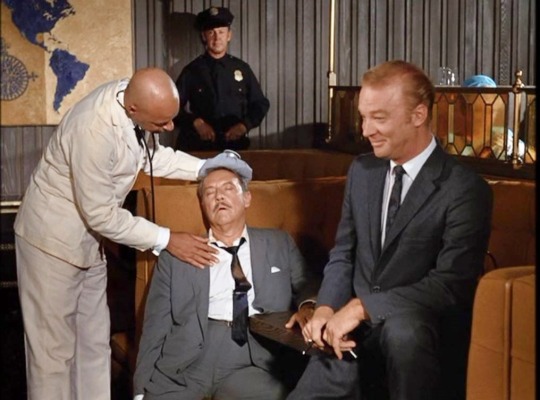
“Lucy and the Great Airport Chase” (1969) ~ Government Agent Bill (Morgan Jones) appears to investigate international epsionage in an episode shot on location at Los Angeles International Airport (LAX). The G-Man is never addressed by name but listed in the end credits.

"Lucy Helps Craig Get His Driver's License" (1969) ~ A motorcycle cop (Ray Kellogg) faces off with driving test examiner Wibur Hurlow (Jack Gilford).
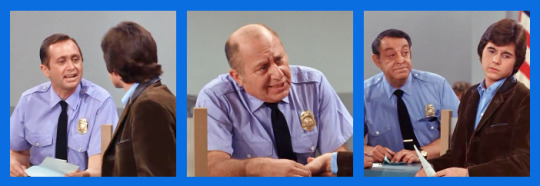
Inside the police station, the officers issuing licenses are played by (left to right): Herkie Styles, Joseph Mell, and Sid Gould.

“Lucy's Burglar Alarm” (1969) ~ Detective Harvey Gaynes is played by Elliott Reid, who also appeared on “I Love Lucy” and “The Lucy Show.”

“Lucy, the Cement Worker” (1969) ~ Lucy disguises herself as a street construction worker to find a valuable ring she’s lost. She encounters the cop on the beat, played by Harry Hickox in the first of his three episodes of “Here’s Lucy.”

“Lucy and Viv Visit Tijuana” (1970) ~ At the border, Harry is questioned by a customs officer played by Don Megowan in his only appearance with Lucille Ball. He is perhaps best remembered as the Sheriff in The Wolfman (1956). His final role was as a police sergeant in the 1979 TV movie Mrs. R’s Daughter.

“Lucy and Wall Cox” (1970) ~ Lucy helps Wally Manley (Wally Cox) get a job as a warehouse security guard where they encounter armed criminals.

“Lucy and Ma Parker” (1970) ~ Carole Cook plays a master criminal. The police convince Lucy to take her place in order to nab her associates. Harry Hickox (Lieutenant L. Hickox, left) makes the second of his three episodes of “Here’s Lucy,” all as policemen. Stafford Repp (Police Detective Halloran, right) made a career of playing policemen even before he became famous as Chief O'Hara on TV’s “Batman” (1966-68). He played two different officers of the law on “Dennis the Menace” in 1962 and 1963, alongside Gale Gordon.
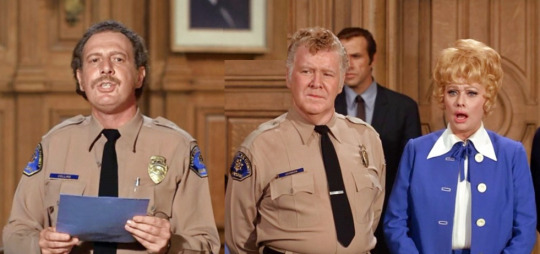
“Lucy and the Raffle” (1971) ~ The Baliffs in the courtroom are played by Emile Autuori and John J. ‘Red’ Fox.

“Lucy and Carol Burnett aka The Hollywood Unemployment Follies” (1971) ~ Lucy and Carol stage a musical revue featuring a tribute to the operetta Rose Marie (1930 & 1940). Four Mounties (Royal Canadian Mounted Police) sing “Stout-Hearted Men”. From left to right: Sid Gould, Kay Kuter, Johnny Silver and Mike Wagner.

“Lucy and Mannix are Held Hostage” (1971) ~ In this cross-over with the Mike Connors private eye series “Mannix” (saved from cancellation by Lucille Ball), the policemen are played by Vince Howard (left) and Robert Foulk (right).
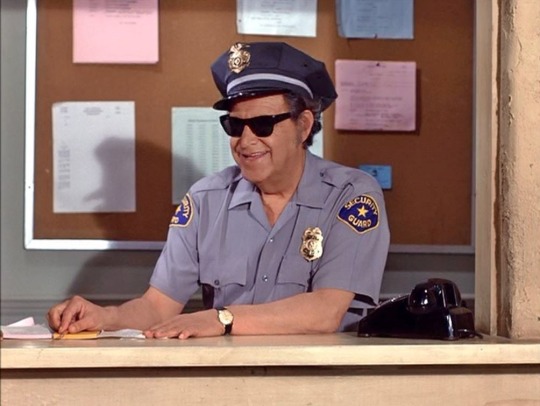
“Lucy and the Celebrities” (1971) ~ Sid Gould plays the Security Guard at the gate of Morton Pictures. Impressionist Rich Little stars with Jack Benny.

“Lucy and the Candid Camera” (1971) ~ Allen Funt plays himself and an evil imposter, getting the Carters to participate in criminal capers under the impression they are on “Candid Camera”. Law enforcement is played by (left to right): Peter Leeds, Robert Carson as Sergeant Lou Holmes, and Paul Sorenson, who played policemen many times during his career.
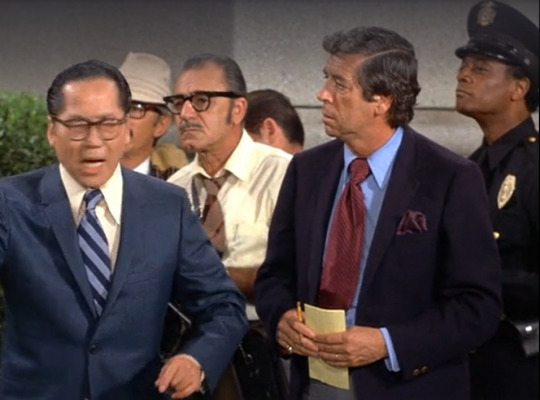
“Lucy and the Chinese Curse” (1972) ~ When Lucy saves a laundry owner (Keye Luke) from a safe falling in the street, reporters and the police are on the scene. Frequent background performer Walter Smith plays the policeman. He had appeared with Lucille Ball in Forever Darling (1956), as well as in Desilu’s “The Untouchables” and “The Lucy Show.”

“The Case of the Reckless Wheelchair Driver” (1972) ~ Lucy, in a wheelchair due to her broken leg, is set-up by a conman (Jesse White). Law enforcement officials are (left to right): Officer Rafferty (Robert Foulk), Sergeant Montgomery (Hal Hickox), and Officer Egan (Ed Hall).

“Dirty Gertie” (1972) ~ Lieutenant Egan is played by Craig Stevens, who is probably best remembered for playing the title role in the private eye series “Peter Gunn” (1958-61). Egan questions Lucy and says he's “just trying to get the facts, ma'am.” This is a paraphrase of a quote from another famous TV detective, Joe Friday on “Dragnet.” The role of Lieutenant Egan was originally written with Webb in mind. Stevens even imitates Webb's deadpan delivery.

“Lucy Goes to Prison” (1973) ~ When Lucy goes undercover in jail to discover where Mumsie Westcott (Elsa Lanchester) hid her stolen loot, Matron Wilson is played by Jody Gilbert, who also played a prison matron on “The Lucy Show.”
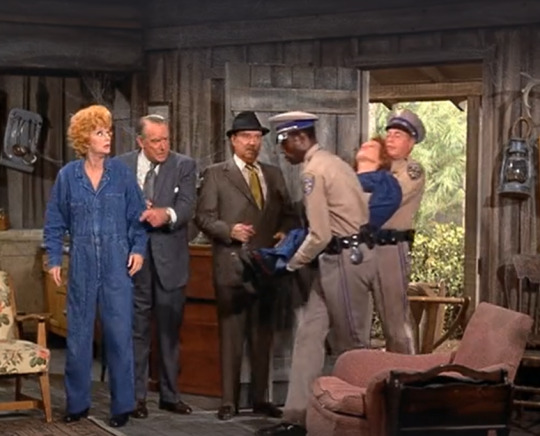
Two uniformed policemen are played by uncredited actors and have no lines.
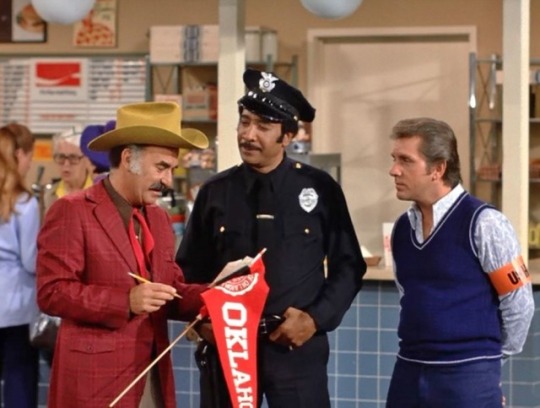
“The Big Game” (1973) ~ Jerry Jones plays a policeman on the prowl for ticket scalpers at the stadium. Prior to this, Jones played a policeman on “The Doris Day Show” and “The Brady Bunch.”
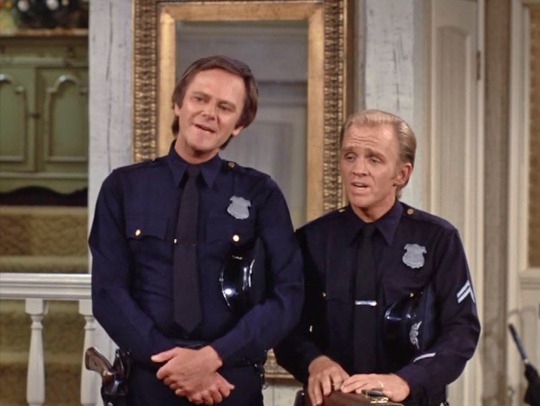
“Lucy Plays Cops and Robbers” (1973) ~ On the side of the law are Officers Spencer and Riggs, played by Dick Sargent and Gary Crosby. Rumor has it that the police officers were supposed to be played by “Adam-12” (1968-75) co-stars Martin Milner and Kent McCord. Like “Here’s Lucy,” the NBC police drama was filmed on the Universal lot. Gary Crosby played a recurring role on “Adam-12.” In the script, one officer says to the other “I think we’ve been riding together too long” which would have been even funnier had it been an already famous pair of policemen like Milner and McCord. The episode features Al Lewis, who famously played Officer Schnauser on “Car 54 Where Are You?” (1961-63).
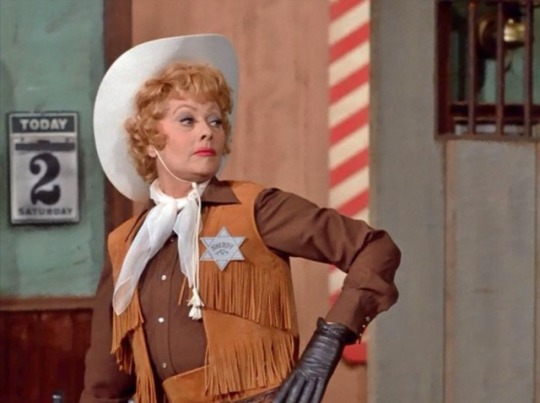
“Lucy the Sheriff” (1974) ~ Lucy finds out that her grandmother was the first woman sheriff of a Montana town that is celebrating its centennial. She is asked to play her grandmother at the celebrations, which include the recreation of a bank robbery. Lucy is enjoying playing lawmaker until a couple of genuine robbers interrupt the celebration and take her hostage!

Flora Belle Orcutt (the fictional one) is supposedly the first lady sheriff in the West. In real life, the distinction of first woman sheriff has been disputed. Some say it was Texan Emma Banister (1918), but others claim it was Mary Roach (1922-27) because Emma had inherited the position from her husband. Still others believe the title belongs to Kansan Mabel Chase (1926). Mrs. James Latty of Burlington, Iowa, was known as the first “Unofficial Woman Sheriff" as far back as 1870.

Lucy the Sheriff meets Sheriff Bart Thomas, played by Orwin C. Harvey.
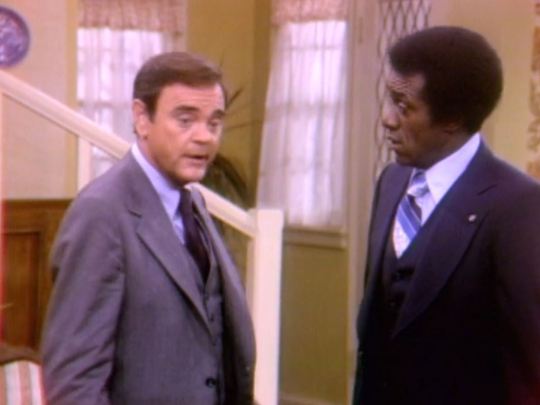
“Lucy Calls the President” (1977) ~ In the CBS special, Lucy Whittaker (Lucille Ball) is scheduled to get a visit from President Jimmy Carter. In advance of the visit, the Barker home is visited by Secret Service Officers Thatcher (Joey Forman) and Stockley (Stack Pierce).

Stone Pillow (1985) ~ Lucille Ball plays a homeless woman living on the streets. When another homeless woman dies on her corner, the police are called. Pat McNamara (Officer Daggett) played Sheriff Perkins in Silence of the Lambs (1991).

“Lucy and the Guard Goose” (1986) ~ This unaired episode of “Life With Lucy” was originally scheduled for broadcast November 22, 1986. When crime hits M&B Hardware, Lucy enlists the help of a guard goose. Charles Levin plays Pasadena’s finest Sergeant Green. Green played a policeman on two episodes of “Punky Brewster” (1987-88).
#Lucille Ball#Here's Lucy#TV#Police#Policemen#Cops#Cop#Gale Gordon#Stone Pillow#Dick Sargent#Gary Crosby#Life with Lucy#Jody Gilbert#Craig Stevens#Allen Funt#Keye Luke#Lucie Arnaz#Jesse White#Elsa Lanchester#Stafford Repp#Mike Connors#Mannix#Van Johnson#Mary Wickes#Jack Gilford#Wally Cox#Elliott Reid#Sid Gould#Desilu#Lucy
2 notes
·
View notes
Text
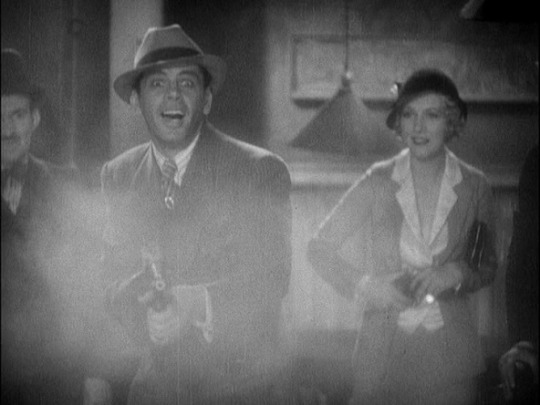
Vince Barnett, Paul Muni, and Karen Morley in Scarface (Howard Hawks, 1932)
Cast: Paul Muni, Ann Dvorak, Karen Morley, George Raft, Vince Barnett, Osgood Perkins, Boris Karloff, C. Henry Gordon, Inez Palange. Screenplay: Ben Hecht, Seton I. Miller, John Lee Mahin, W.R. Burnett, based on a novel by Armitage Trail. Cinematography: Lee Garmes, L. William O'Connell. Set designer: Harry Oliver. Film editing: Edward Curtiss
Like so many early talkies, Scarface feels a little off in its pacing at times, especially in scenes with dialogue, as if the director was uncertain how much of the exposition was getting across to the audience. Which is surprising, considering the director is Howard Hawks, the master of fast-paced repartee. But the real Hawks shows up eventually, especially in the action scenes, and in some brilliant bits, such as the murder of Boris Karloff's Tom Gaffney in the bowling alley. We see Gaffney start to fall after the shot, but the camera follows the track of the ball he has just bowled: It's a strike, but one pin wobbles uncertainly for a second before toppling. François Truffaut commented on the scene, "This isn't literature. It may be dance or poetry. It is certainly cinema." For many, Hawks's Scarface has been overshadowed by Brian De Palma's 1983 version, and its rough contemporaries Little Caesar (Mervyn LeRoy, 1931) and The Public Enemy (William A. Wellman, 1931), the gangster films that set Edward G. Robinson and James Cagney on their road to fame, shadowed the Hawks film at the time, delaying its release as Hawks and producer Howard Hughes wrangled with the Hays Office censors, who were edgy about the plethora of gangster films. In response to their objections, the film has no fewer than three screens full of text before the movie actually starts, proclaiming that it's "an indictment of gang rule in America and the callous indifference of the government to this constantly increasing menace," and exhorting the audience to demand that the government do something about it. Later there are clearly interpolated scenes that suggest some of the things the government can do include gun control and immigration reform or even the imposition of martial law. The film was even released with a subtitle, Scarface: The Shame of a Nation. This heavy-handedness suggests that Hughes had less clout with the Hays Office than did Warner Bros., which didn't jump through quite so many hoops in releasing Little Caesar and The Public Enemy. Nevertheless, Scarface was a box office success, largely because it's a hugely entertaining film, showcasing what may be Paul Muni's best screen performance -- the only other contender would be I Am a Fugitive From a Chain Gang (Mervyn LeRoy, 1932). Muni has a leering, gleeful quality as Tony Camonte; he's almost sexy, which is something that would never be said of the actor after he began to take himself seriously in William Dieterle's stodgy biopic celebrations of Great Men like The Story of Louis Pasteur (1936) and The Life of Emile Zola (1937). Because Scarface was made before the Production Code clampdown on sex, it's pretty clear what's going on between Tony and Karen Morley's Poppy, but also that Tony's relationship with his sister, Cesca (Ann Dvorak), has a touch of the perverse about it. The film is full of delicious asides, too, like a minor character, a reporter known as "MacArthur from the Journal," a tip of the hat to screenwriter Ben Hecht's former colleague in Chicago journalism, Charles MacArthur, who was also his co-writer on the play The Front Page. The character is played by Hecht and MacArthur's friend John Lee Mahin, one of the screenwriters on Scarface.
4 notes
·
View notes
Text
NOTES (1997)
The Lost World: Jurassic Park is the sequel to Steven Spielberg's 1993 film recounting events on a Costa Rican island inhabited by genetically-engineered dinosaurs, which broke all box-office records and showcased an emerging visual effects technology.
Based on the novel by Michael Crichton, the story picks up four years after the disaster at Jurassic Park. Something has survived on a second island Isla Sorna, where the dinosaur manufacturing facility code-named Site B has been destroyed by a hurricane and the animals now run free, constrained only by the laws of nature.
"When I first heard that Michael was going to write the book and that he was thinking of calling it The Lost World, I was thrilled because I'm a big fan of Sir Arthur Conan Doyle's book The Lost World. I was compelled by the idea of being inside a prehistoric world that exists today - not behind electrified fences, not in a theme park, but in a world without the intervention of man. I thought, 'Wow, what a great story.' If I hadn't found a story I was interested in, Jurassic Park would have remained just a nice memory for me," says Steven Spielberg.
For Spielberg, who had been carefully considering a number of projects for his return to directing after a three-year hiatus, Crichton's interest in revisiting the Jurassic saga helped sway his own decision. Universal Pictures and Amblin Entertainment, Spielberg's production company, had begun discussing a sequel to Jurassic Park as the original film was breaking box-office records around the world en route to becoming the highest-grossing motion picture of all time. Now, Spielberg, Crichton and Jurassic Park screenwriter David Koepp entered into a gentleman's agreement to bring The Lost World to the screen, under the Universal-Amblin umbrella.
"I realized that what I really wanted to do was direct. I had started a company and done a lot of other things in those three years. So I was ready to return to it, and I had always wanted to do a sequel to Jurassic Park - both because of popular demand and because I'd had such a great time making the first film," Spielberg reflects.
With the deal in place, Spielberg began to pull together a creative team, nearly every member of which was a veteran of Jurassic Park. Serving with Spielberg were producers Gerald R. Molen and Colin Wilson. Executive producer Kathleen Kennedy would also return to the fold, along with production designer Rick Carter, film editor Michael Kahn and composer John Williams. With full motion dinosaurs by Dennis Muren, live action dinosaurs by Stan Winston and special dinosaur effects by Michael Lantieri, this Academy Award®-winning triad that had combined talents to create the dinosaur effects for the first film also committed to the sequel. Of all the department heads, only director of photography Janusz Kaminski - who had shot Schindler's List for Spielberg - was not an alumnus of Jurassic Park.
In The Lost World: Jurassic Park, Jeff Goldblum reprises his role as chaos theorist Ian Malcolm and Richard Attenborough makes a special appearance as the ambitious entrepreneur John Hammond. Julianne Moore (Nine Months ), Pete Postlethwaite (In the Name of the Father ), Arliss Howard (To Wong Foo, Thanks for Everything! Julie Newmar ), Vince Vaughn (Swingers ), Vanessa Lee Chester (Harriet the Spy ), Peter Stormare (Fargo ), Harvey Jason (Air America ), Richard Schiff (City Hall ) and Thomas F. Duffy (Wolf ) join Goldblum in the cast.
The Lost World: Jurassic Park is Spielberg's first film since 1993, when he directed both Jurassic Park and Schindler's List, which won a total of seven Academy Awards® including Best Picture and Best Director. Jurassic Park was also honored with three Academy Awards® including Best Sound, Best Sound Effects Editing and Best Visual Effects.
It was clear that Universal wanted to talk about doing a sequel in the record-setting period following the release of the original film. (With worldwide ticket sales of more than $916 million, Jurassic Park continued to break records when it was released on home video, where it holds the title of top-selling live-action motion picture of all-time.) The filmmakers had discussions amongst themselves and with Michael Crichton.
While there was interest in a sequel, there was no guarantee that Crichton was going to write another book. Determining a schedule for a second Jurassic Park film was dependent on whether Crichton would proceed.
Meanwhile, Spielberg and screenwriter David Koepp were already talking. Yes, the director confirmed, there would be interest in an encore, if there was a good story to be told.
In those heady months after the release of Jurassic Park, when the question of whether dinosaurs could be made real was answered with a resounding affirmative, there was a new question. "Sure you can do dinosaurs, but what can you do with them?," Koepp remembers thinking.
So began the dialogue between the filmmaker and the screenwriter, who were getting together from time to time to just bounce ideas off one another, recalls Koepp.
Word that Crichton was working on the manuscript for his follow-up novel only served to sharpen Koepp and Spielberg's wild imaginations. "We'd throw ideas at one another and see what kind of reaction it provoked," recounts Koepp. "Suddenly I'd say something and that made him think of something that made me think of something. It just feeds in that way."
Spielberg would go off from these brainstorming sessions and storyboard the ideas. "Steven's got such a wonderful, fertile mind, especially for these sorts of adventure sequences and action sequences," says Koepp. His challenge as a writer was to figure out how to incorporate what he describes as "these fantastic sequences" into the loose structure of a movie that he had in mind and then integrate them with Crichton's work.
"In an interesting way, this is a lot like the way animation works where you start with a visual idea and then, in a very logical way, craft the story," observes executive producer Kathleen Kennedy. "Our story was very dependent on the visual imagery."
"When you have Michael Crichton and the book, you are already in very good shape," says Kennedy. "Add to that the combined imagination of Spielberg and Koepp and you have the basis for a very exciting film."
One of the challenges in approaching The Lost World was the audience's own enormous expectations. As Koepp observes, "audiences tend to feel pretty proprietary about it. Everybody has their own ideas about what should happen in a sequel."
Fortunately, Spielberg has never forgotten his own experiences at the movies going back to his boyhood days when his father took him to see Cecil B. DeMille's The Greatest Show on Earth. He was amazed by the power of the cinematic experience and soon started to make movies with friends and members of his family. "The audience comes first," says Spielberg. "I really think of the audience when I think of a Jurassic Park or a Lost World or the entire Indiana Jones series. A lot of this movie was made for what I hope is the pure pleasure of an audience."
The result is a movie that is both similar and different - an intense, visually stunning adventure that pushes the limits of imagination and technology.
Audiences will embark on this new adventure with a familiar face as their guide. "I cast Jeff Goldblum again because he is Ian Malcolm," says Spielberg. "There is no Ian Malcolm except as played by Jeff." This time, Dr. Malcolm is the anchor for the story. "In the first film, Malcolm was along for the ride and he was kind of a critic," Spielberg continues. "In this sense, he's leading the journey in The Lost World. He has a very strong motivation for returning."
Jurassic Park ushered in a new era of visual effects, brilliant computer-generated images (CGI) blended seamlessly with the state-of-the-art mechanical and animatronic special effects. The combination gave life to creatures believed to be extinct for 65 million years. "I think that people were a little bit amazed that the dinosaurs looked as real as they did," says Spielberg.
But whereas moviegoers in the summer of 1993 were awestruck by the on-screen digital recreations, audiences today will come to the theaters expecting to see nothing less than living, breathing dinosaurs.
"With the first movie, we had no idea how we would make the dinosaurs real," admits Kennedy. "With the sequel, we had a very clear idea of the visual effects and were very comfortable with the technology for computer graphics. So for The Lost World, we were able to focus on the storytelling."
"It was the story that justified doing a sequel, not the technology," Spielberg comments. "CGI has improved since the first movie and the artistry of the people involved has also improved. So there was a good chance that the dinosaurs would look even more believable than they had in the last adventure. But it was really the story that compelled me to make this movie."
The notion of a lost world, a window on earth's distant past, inspires the imagination. The occasional real-life discovery of a prehistoric link - such as the ancient coelacanth: the 400 million-year-old fish found still to be alive or prehistoric insects found perfectly preserved in amber - fuels these dreams. Sir Arthur Conan Doyle visited the subject in his turn of the century Professor Challenger series. Somewhere beyond Doyle's vision of an evolutionary anomaly and John Hammond's technologically marvelous Jurassic theme park is The Lost World.
On another island off the coast of Costa Rica, in a chain called Los Cinco Muertas (The Five Deaths), dinosaurs are living and breeding in the wild. This is Site B. "A genetic laboratory, the factory floor, so to speak," explains Spielberg, where once upon a time experiments and cloning attempts not suited for public exhibition were conducted by InGen scientists.
The behind-the-scenes laboratory was knocked out of commission, but nature found a way. For four years now, dinosaurs have flourished in a perfect ecological system unfettered by man.
As The Lost World begins, the balance of nature is about to be tested once again. Peter Ludlow (Arliss Howard), John Hammond's mercenary nephew, has taken over the nearly bankrupt InGen. In a presentation to the board of directors, he unveils a plan to restore the corporation's financial health by harvesting the "significant productive assets that we have attempted to hide." For him, Site B is a giant cash cow just waiting to be milked.
Hammond (Richard Attenborough) is well aware of the commercial potential in Site B. But he sees another opportunity: a chance to redeem himself by preserving a record of the dinosaurs living in their natural state.
"Finally, what he will have done will not be a terribly tragic thing, but a contribution," says actor Jeff Goldblum.
"He's a dreamer," says Lord Attenborough of his character. "He's not unlike Mr. Spielberg, to a certain extent, in that he is fascinated by the infinite capabilities of human endeavor. Hammond just goes that much farther." The Jurassic Park founder is somewhat chastened and tempered by what has happened before. "But the old temptations and the old adrenaline comes up and he takes risks again."
Hammond organizes an expedition to reach the island before Ludlow lands his own, less noble mission led by Roland Tembo (Pete Postlethwaite), a leathery adventurer and hunter. To accomplish this he commissions Nick Van Owen (Vince Vaughn), a daring video-documentarian, to chronicle the trip; Eddie Carr (Richard Schiff), a field equipment systems specialist, to outfit the team and keep the operation running in the field; and Dr. Sarah Harding (Julianne Moore), a pioneering paleontologist specializing in the nurturing behavior among carnivores - especially carnivorous dinosaurs.
"Sarah is opening up a new field of study, and she uses this as an opportunity to explore her beliefs," Spielberg observes. "She has an insatiable curiosity." Which is exactly why Sarah mentioned none of this to her boyfriend, Ian Malcolm, who would have tried to stop her had he known. When Hammond asks Malcolm to lead the venture, he refuses - until Hammond informs him that Dr. Harding is already there.
The revelation that his girlfriend is alone on an island with dinosaurs drives Malcolm into action. "It's a very monumental moment for me," Goldblum explains. "I go down there with a head full of steam and a gut full of passion."
Of the people who reach the Lost World, only Malcolm comprehends the danger. He knows from experience that people shouldn't be where dinosaurs are. "It's going to be bad for people," Goldblum says dryly. Among these people is Kelly Curtis (Vanessa Lee Chester), a young stowaway, whose presence on the island raises the stakes even higher for Dr. Malcolm.
In Jurassic Park, Malcolm was more of the moral, conscience-driven intellectual drawn to the exotic park out of curiosity. "This time," says Goldblum, "I've got a very emotional, passionate and driving reason to bring me back. I am a force of nature."
"Drama is often like rubbing two sticks together and watching what it sets aflame," notes Spielberg of the confrontation between the two philosophically-opposed expeditions - one sent to protect the sanctity of the habitat and the other to roundup the animals for commercial exploitation - who "end up having to band together just to survive. That creates more than just a lot of running from dinosaurs - there's a great deal of emotional drama, as well."
Screenwriter Koepp remembers a conversation in which Spielberg told him, "I think this movie is about hunters versus gatherers." Koepp adds "that when the two groups are thrust together into survival situations is when it gets really fun."
Jurassic Park raised the question of man's role in trying to control nature. "You decide you'll control nature and from that moment on you're in deep trouble because you can't do it," says Michael Crichton. "You can make a boat, but you can't make the ocean. You can make an airplane, but you can't make the air. Your powers are much less than your dreams would have you believe."
The debate continues in The Lost World; this time the argument is framed by setting the story in the dense forest wilderness, where man's impact on life and the environment is clearly evident. As the Native American Chief Seattle observed a century ago, "Man did not weave the web of life, he is merely a strand in it. Whatever he does to the web, he does to himself."
"The Lost World is exactly what it implies," says Spielberg. "A lot of people who think they can control nature are very presumptuous about their role in the scheme of things and wind up on the short end of the food chain. You have to band together to live and go on."
"It's important in these movies that animals never be characterized as villains, because they are not," Koepp points out. "They're just doing what they do. It's when the humans come into conflict with one another that they may find themselves at the mercy of the animals."
"On one level, this story evolved into one about parenthood and the instinct to protect your young," he continues, echoing a theme that applies to the films human and animal characters. On a more superficial level, the story evolved into one of survival.
Then there is the moral question explored in Jurassic Park. "DNA cloning may be viable, but is it acceptable?" asks Spielberg. "Is it right for man to do this or did dinosaurs have their shot?"
The controversy over cloning - it's possibility implied in Jurassic Park and proved in real life in February 1997 when researchers in Great Britain announced their success in cloning a sheep - raged anew on the front page of newspapers just as The Lost World was in post-production.
Spielberg always respected the science behind Jurassic Park as real, much as he respected real-life research as the basis for his other projects, such as Close Encounters of the Third Kind .
Contained in those news stories was another point that confirmed what Crichton, Koepp and Spielberg suggested in their latest adventure. The failure rate in cloning an animal is presently staggering: on the order of 300 to 1. For every success, there were numerous failures, from death to deformity, if the cloning procedure took at all. As Hammond tells Dr. Malcolm, he needed a factory, Site B, to overcome this ratio and stock Jurassic Park with the perfect specimens visitors saw there.
"A movie like this needs at least a year to 18 months of prep time," says Spielberg. "You can't just throw this together in a normal four-month prep for a drama or a comedy. It takes 18 months to build the animals. We began sketching and designing some of the sequences about two years ago."
In the spring of 1995, production on The Lost World: Jurassic Park started to come together. Producers Gerald R. Molen and Colin Wilson, both longtime Spielberg collaborators who were veterans of the first movie, began to focus their substantial producing skills on the project. Molen roughed out a schedule and budget as Michael Crichton was concluding his novel and Spielberg and screenwriter David Koepp were developing ideas for the screenplay. Colin Wilson, who oversaw the visual effects work and was largely responsible for the post-production on Jurassic Park while Spielberg was in Poland making Schindler's List, reassembled the visual effects team from the first film and began to address the dimensions of the new project. Dennis Muren at ILM, Stan Winston and Michael Lantieri were all eager to apply newly-developed technologies to better what they accomplished with stunning effect on the first film.
Production designer Rick Carter, who also designed the look for Jurassic Park and has been associated with Spielberg and his production company since the Amazing Stories television series, began his work on The Lost World when he and storyboard artist Dave Lowery met over dinner with Spielberg that spring. "We just started storyboarding one of the scenes from the book and it evolved from there. By the fall, we had a full crew of set designers, art directors and illustrators," Carter recalls.
"It's my job to find a lost world and then create The Lost World," Carter continues. "In this particular film, we are coming back to the same type of place where we were in the first film but it's a lot rougher." That this more natural, wild environment is less hospitable to the dinosaur population than the safe containment of the man-made park of the first movie can be seen in the battle-scarred head of the male T-Rex.
Carter and his team constructed various environments based upon what they knew as the outline of the movie. "We would show Steven our ideas for sets and when he approved them, that would often spark ideas - right on the spot we'd come up with more and more scenes, and those would be storyboarded and become part of the actual story."
The preliminary visualization phase continued as Carter, his art directors, draftsmen and illustrators refined the ideas into models. Carter also turned to the computer for help in determining the look of many of the visual effects sequences. He made rough 3-D animations, called animatics, which show characters moving within an approximation of the set.
"In this kind of movie, so much is being constructed visually," notes Carter, contrasting the open, organic process of creating The Lost World with other projects where the look is strictly determined by "a narrative we absolutely adhere to at all times."
The storyboards, animatics, illustrations and models created by Carter's art department provided the foundation for the entire production. The storyboards gave every member of the growing production team a clear idea of Spielberg's vision - information they would use to prepare their portions of the picture. They were constant throughout production with filmmakers using them as a guide from the earliest days of prep right through post-production. On the set, for instance, storyboards for each day's work were posted on a large display board. As pieces of the sequence were shot, the corresponding storyboard was marked as complete.
Storyboards for the big set piece action sequences were released to the visual effects teams early to give them as much time as possible to complete the intricate task of flawlessly interlacing digital, physical and robotic effects. There was no question that the visual effects for The Lost World would be every bit as challenging as they were on the first film. Perhaps even more so because audiences that had modest expectations for the first film's dinosaurs would now expect greatness.
Stan Winston was already well on his way to creating an entire new set of dinosaurs at his studio in Los Angeles' San Fernando Valley. New technology and such seemingly simple things as improved hydraulic systems were developed in the years between Jurassic Park and The Lost World. As dazzled as audiences were with Winston's brilliant work on the first film, he knew that he could do even better and was determined to prove the point.
"People are very aware of the advancements in the computer world since Jurassic Park," Winston comments, "but they tend to forget that the animatronic world has also made some incredible advances, producing characters in which the technology is virtually undetectable. In large part, that is due to the tremendous advances we made in Jurassic Park and in the time since then."
"There were tremendous developments in hydraulic technology - developments that allowed us to manufacture twice the number of creatures in half the amount of time and for slightly less money," Colin Wilson elaborates. "That was quite amazing. We got a lot of improvements in performance and technology. We got double the number of characters, and we paid less for it. But the most important part of the equation was how much better the character performances would be for this movie."
The sequel gave Winston the opportunity to make dinosaurs that were even more lifelike. But it wasn't just a matter of refitting the creatures from the first film with new movements and armatures. To begin with, there are more dinosaurs in The Lost World. So while the retooled T-rex from the first film joins Goldblum and Attenborough as a returning cast member, Winston and his crew built a second adult T-rex from scratch and fabricated nearly 40 creatures in all. The Stan Winston Studio, located in an industrial section of Van Nuys, utilized the talents of more than 100 artists and technicians during the year and a half that it took to design, draw, sculpt, mold, frame, mount and paint the different dinosaurs. There was diversity, too: from the tiny chicken-sized Compsognathus ("compy") to the two-story-tall T-rexes.
The work also involved careful coordination with the other two captains of the visual effects squad. Lantieri, who heads up the mechanical effects team, worked closely with the Winston shop to fabricate the giant T-rex frames and movements, as well as several other design issues. The Winston Studio's maquettes, scale models of the finished dinosaurs, were shared with Muren and his team at ILM, where they matched the colors, textures and movements of the digital creatures so that they would mesh seamlessly with Winston's live-action dinosaurs.
Part of what makes Winston and his creatures so magnificent is his approach. He doesn't think of them in a mechanical sense, and he couldn't tell you exactly how to build them. He doesn't look at his creations as inanimate robots. Instead, he thinks of them as characters, performers and stars. "We give them personalities. They have expressions," he says.
In fact, it is Winston's own background - first as an actor, then as a make-up artist and more recently as a director - that helps him keep his crew focused with this idea. On the set, as he stands next to Spielberg, he speaks to his puppeteers through headsets, intoning cues and direction for their "performance."
The animal characters created by Winston proved to be a benefit for the human actors, as well. It gave them a real representation - an actor, so to speak - to play against.
To add to the authenticity of the dinosaur fabrications, Spielberg once again enlisted noted paleontologist Jack Horner of the Museum of the Rockies, who had served as an advisor on Jurassic Park. This noted scholar, who is one of the world's foremost fossil hunters, worked very closely with Spielberg and Winston in creating lifelike representations of these long extinct creatures. Although much of our dinosaur knowledge is based on speculation, Horner revealed that there is much that can be deduced by putting knowledge of today's skeletal science together with the fossilized bones. Like a detective, Horner and other researchers like him are able to develop detailed ideas of what dinosaurs looked like and how they behaved - knowledge that Spielberg and Winston readily applied to their work in The Lost World .
Horner's work with Winston was especially important because the look and movement of the Winston dinosaurs would become the basis, most notably in terms of appearance and texture, for the digitally created dinosaurs that Muren would produce.
In San Rafael, California, Muren was gathering his legion of digital artists at Industrial Light & Magic. Since Raiders of the Lost Ark, Spielberg has relied upon the collective talent at ILM, and one way or another Muren has been a part of it all.
Digital technology is moving with such velocity that techniques painstakingly developed at the beginning of Jurassic Park were surpassed by improvements before production was over. There was tremendous desire on the part of many who worked on the original film to finesse the visual effects to an even higher level. "This show is a lot different from Jurassic Park in that we were sort of timid on the first one because we didn't know if we could do it," says Muren. "Now we figured out we could do it and have had three years to think about it."
Like Winston, Muren wanted to improve on what he did with the first movie. This time he wanted to give Spielberg something else: freedom. "At the beginning of the show I mentioned to Spielberg that we can do just about anything," Muren relates.
The idea and overarching philosophy driving Muren and ILM is that filmmakers shouldn't have to think about the technology so that they can be free with the images. So, for over 20 years, we've been building up tools to give these directors what they want without restraint.
Examples of this independence include the ability to shoot visual effects shots with complete freedom of movement for the camera and a greater degree of interactivity between the CG creatures and live action actors. Visual effects shots used to mean locked-off cameras and rigid procedures. But technology has advanced to the point where the visual effects camera can be mounted on a steadicam and moved about with total fluidity.
No matter how wonderful and real the work of Winston and Muren appears to be, it wouldn't play as well without the third element of the visual effects team - Lantieri's physical effects. Lantieri, one of Hollywood's most skilled effects men and another longtime member of the Spielberg team, remarked that he had more work to do in the final weeks of the 14-week shoot on The Lost World than he did throughout Jurassic Park. "Everything about this show is big," says Lantieri. "On the last show, we crashed an explorer. This time we dangle a 60-foot-long double trailer off a cliff."
The largest set piece that Lantieri had to create involved the massive field systems trailer, which was designed to provide a base of operations for Dr. Malcolm and his travelers. To begin, there was not one but five trailer sections - all modified Fleetwood motor homes. There were literally hundreds of moving parts both inside and out and all of which had to be rigged by the special effects unit. Before the end of the movie, all manner of damage is inflicted upon the trailer and its human occupants, and Lantieri had to figure out how to make it all happen. The sequence, spread across almost a month of the shooting schedule, was filmed on two soundstages and the side of a parking structure dressed to look like a cliff wall.
Simultaneous to the visual effects development, Carter began a real-life search for a Lost World. He traveled extensively, looking in the Caribbean, Central America and as far away as New Zealand for places that visually conveyed the idea of a Lost World - a place forgotten by time and humanity.
He found his Lost World closer to home - in the Redwood Forests near Eureka, California, about six hours north of San Francisco on California's aptly named Lost Coast. With tremendous cooperation between the filmmakers and the California State Parks, the company was allowed to shoot in the midst of some of California's most spectacular scenery in Fern Canyon, Prairie Creek and Patrick's Point State Parks.
In a film defined by its scope and scale, the tall and massive trees, known as the Coast Redwood, were about the only thing that could dwarf this production. The Redwood settings were interesting for another reason: the trees have an ancient history dating back more than 160 million years. According to John B. Dewitt of the Save-the-Redwoods League, "Redwood Forests, as we know them today, have been present in California for about 20 million years. They represent a unique and beautiful relic flora from the days when dinosaurs roamed the earth."
For the film's opening sequence, Spielberg returned to Kauai, Hawaii, where he previously shot portions of Jurassic Park and Raiders of the Lost Ark .
While Eureka and Kauai provided most of the rich and forested Isla Sorna exteriors, much of the film was shot within Southern California and on the Universal Studios stages and backlot where all of the sets were constructed.
With the project now increasingly defined, Gerald R. Molen and Colin Wilson, joined by associate producer Bonnie Curtis, spent several months lining up the crew and a multitude of production elements. "My job is to provide the director with the tools necessary to do what he wants to do," says Molen. "The most important thing is to find the right people."
By April 1996, a year after Spielberg began to seriously plan the picture, most of the locations were picked, sets designed and the crew was largely in place to prepare for a start date of September 5 - still five months away. While the visual effects teams were already well into their work, others were just getting started, and some were not to start until the end of summer.
In June, construction coordinator John Villarino opened up his office on Universal's Stage 12, the second largest sound stage in the world, and started a job that would ultimately fill six of Universal's biggest sound stages wall-to-wall with sets.
Villarino worked mainly from models, illustrations and prints provided by the art department. By the end of the show, Villarino figured that his crew of 120 actually constructed 80 of the total 100 different sets. "There wasn't enough stage space in Hollywood to do this movie. It would have taken another four stages," he says, but they just didn't exist.
Carter addressed the stage space issue by devising a way to change over the stages from one set to another throughout the show. For instance, on Stage 12 Villarino changed over the set three times. The company would shoot on the stage, leave to shoot on another stage for several days and then return to a completely different set configuration. "It was kind of hectic," Villarino allows.
The massive T-rexes also presented a challenge to the production. Stars in their own right, they required special handling.
The T-rexes, which each weighed 19,000 pounds and ran on tracks, could not be moved from their home on Stage 24. Instead, sets were built around the T-rexes. This occurred regularly throughout production.
One of the largest sets constructed for The Lost World was the workers village on Site B which was left intact after filming to become a part of Universal Studios Hollywood theme park tour. The operational center, where at one time InGen scientists performed feats of genetic engineering that ultimately led to the cloning of dinosaurs for Hammond's Jurassic Park, was built from the ground up to look as if it had been destroyed by a hurricane and abandoned by the company.
So much of The Lost World takes place on this isolated island, and it is a very green world. One of the busiest greens crews ever to work a film feverishly dressed and maintained each stage. Greens coordinator Danny Ondrejko led a team of 14 greensmen, five of whom would normally be completely in charge of a full production. Instead, Ondrejko put each in charge of a stage or a group of sets.
When you're shooting in a forest, like the Redwood Forest, you don't think about having to dress in with greens. "It's like bringing coal to Newcastle," laughs Carter.
But the truth is that lots of greens carefully screened by the supervising park rangers to avoid contaminating the ecological balance were brought into the forest and removed. The reason: only certain kinds of plants were available in Southern California, and since most of the film was shooting in Hollywood, those were the most practical plants to choose. So the greens department brought supplies of Southern California greenery to Northern California so that close-up shots would match.
Principal photography for The Lost World: Jurassic Park began on September 5, 1996 in the spectacular Fern Canyon, about 40 minutes north of Eureka.
The company spent two weeks in Northern California, filming in a combination of state parks and private land. Within a week, Spielberg was already ahead of schedule.
By the time the Eureka shoot was over, key live action scenes had been captured, dinosaurs were on film, and all of the plates for Industrial Light and Magic's (ILM) three major computer-generated (CG) sequences and nearly half the CG plates for the entire show had been filmed. Within days, those plates would be cut into scenes and delivered to ILM to start their computer animation of the CG dinosaurs.
Throughout the fall, the filmmakers shot on stages at Universal and a select group of surrounding locations.
Janusz Kaminski, the director of photography who won an Academy Award® for his work on Schindler's List, noted Spielberg's approach to The Lost World. "The camera became really active and ended up being in more unusual places than in his latest movies."
Kaminksi and his grip and electric crew employed virtually every camera and lighting device known to the industry and more than a few custom tailored for this film. For example, there were two movable camera mounts, one that functioned something like an elevator and another that allowed the camera to dolly - suspended upside-down from the ceiling of Stage 27.
"It's very much a Spielberg movie where the camera sweeps the scenario," Kaminski continues. "It moves from high angles into extreme close-ups, follows the actors and reflects the drama of the movie and the story."
For the actors, The Lost World was the most physically demanding film any of them had ever worked on. Whether they were suspended on wires or being tossed about in the mud, there was seemingly no limit to the physical manifestations of dinosaur encounters. They sometimes likened the experience to being on an amusement park ride. According to Vince Vaughn, "The difference is that in an amusement park, you take the ride once and its over."
"Part of the joy and challenge of working with Steven Spielberg," says executive producer Kathleen Kennedy, "is that he constantly pushes himself to do things in an unconventional and exciting way. He challenges all of us to go beyond anything that's been done before."
The biggest challenge for producer Gerald R. Molen was to keep the production on track and on budget. "The budget was a little bit higher for this movie than it was for the first - which was about $58 million - but we were actually able to get more for our money this time," Molen notes. "We got more from Stan Winston and his people because a lot of the research and development had already been dealt with for Jurassic Park. We also got more from ILM, in part because the cost of CG had decreased. Also, Steven had decided to get as much as he could from the mechanical dinosaurs, without resorting to CG more than was necessary. So even though this movie would have a few more CG shots than Jurassic Park, it wouldn't have a great deal more."
"Steven was able to do that, to plan for it and budget for it, because he is such a visionary. He is able to see the entire movie in this mind long before he starts to shoot so he knows exactly what he needs. He isn't the kind of director who ends up with a lot of film literally on the cutting room floor. There is no waste. Because of that, we were able to budget this movie very carefully and responsibly."
On December 11, Spielberg lifted his glass in a champagne toast to the crew, just as he had on the final night of filming Jurassic Park. Congratulating them for bringing the film in ahead of schedule, he said: "Thank you for a great show."
It was an emotional send off to what had been an exhilarating experience for everyone involved in the making of The Lost World: Jurassic Park. Knowing up front that the toughest thing about a sequel is the expectation that goes along with it, this veteran production team never got distracted worrying about how they were going to top the first movie.
"Our response to that expectation was to make a different, more dramatic movie, while keeping the humor and suspense and all of the things that audiences had liked about the first movie," Spielberg concludes. "I think that's what people want in a sequel, anyway. They want to roll up their sleeves and fall right back into that adventure."
3 notes
·
View notes
Text
next episode they drug howard but it doesnt work so kim breaks into the HHM office and straight up strangles the man to death to finish the job. bravo vince
3 notes
·
View notes
Text
BETTER CALL SAUL (SERIES REVIEW)
He wasn't always Saul Goodman, ace attorney for chemist-turned-meth dealer Walter White. Six Years before he begins to represent the most notorious criminal in the state's history, Jimmy McGill is a small-time attorney hustling to make a name for himself. However, after chance encounters and numerous bad decisions, he soon begins to lose himself as he slowly evolves into Saul Goodman.
"I'm gonna be a damn good lawyer, and people are gonna know about it."
If you would have told me a couple of years ago that a spin-off from one of the greatest television series of all time, Breaking Bad, would not only match in quality but exceed it. I would have told you that you were out of your mind. Yet, here we are with Better Call Saul. A heartbreaking series about relationships and how those relationships create us. As we see a character fall from grace and descent into sin caused by both his own ambition and those who constantly look down upon him. It takes the story of Breaking Bad but adds more layers and complexities that no one could have imagined.
We begin the series as we see humble but sleazy lawyer Jimmy McGill in his closet law office, barely getting by as a public defender, getting swept up in the Drug Cartel. As the seasons go by, we watch in horror as we see the moral character of Jimmy McGill slowly deteriorate and turn into Saul Goodman. Yet, unlike Breaking Bad, there is a tragedy in Jimmy's descent to sin. Series Creators Vince Gilligan and Peter Gould add numerous layers of moral ambiguity and complex ethical dilemmas to this character study. These conflicts, with no clear right answer, add to the tragedy of the character of Jimmy McGill and the rest of the ensemble of characters.
We, the audience, are treated to these complex ethical conflicts and character relationships and how our characters are pushed to their physical and moral limits. We watch as the morally righteous Chuck McGill turns Jimmy into Saul Goodman by seeing him as nothing more than a common criminal by sabotaging his career as a lawyer out of jealousy and spite. Furthermore, Chuck and Howard push our moral compass of the show, Kim Wexler, towards criminality and Saul out of spite. Even Nacho, a man wishing to get out of the cartel to pursue an honest life with his father, is pushed to his moral and physical limit by those who treat him as nothing but a toy to play with. These conflicts and many more are the heart of Better Call Saul.
Better Call Saul's story is handled like a big chess game, with each subplot and element being a piece of the board. Each element knows precisely when to make its move as the series slowly progresses to its climax. Like chess, it's a slow burn with bursts of tension littered throughout the game. These bursts can be courtroom debates, relationship fallout, or cartel shootouts. The subplots know exactly when to make their moves as they become some of the most stressful and heartbreaking pieces of television I've ever seen. Another element that adds to the chess game of Better Call Saul is the dialogue.
The dialogue in Better Call Saul is itself a chess game. It's smart and witty as we see the ensemble group of characters climb their way to the top. We see genuine emotional and human connections between our characters. While, at the same time, screwing each other over in the name of power and greed with only a few words. These words will resonate and haunt you for the rest of your existence, such as the following last words from Chuck " Let me put your mind at ease, Jimmy. You don't have to make up with me. We don't have to understand each other. Things are fine the way they are. Hey. I don't want to hurt your feelings...But the truth is you've never mattered all that much to me. "
With the excellent dialogue and characters, an equally outstanding ensemble was needed to bring these characters to life. They succeed by bringing an ensemble worthy of numerous Emmy Awards. Bob Odenkirk returns to his iconic character, yet this time around, he is more than a sleazy, charismatic, and charming lawyer. This time, he portrays a man's slow descent into sin. He masterfully portrays his character's internal moral conflicts perfectly. His performance is heartbreaking and profound. I am amazed to this day that he has not won an Emmy yet for his performance as Jimmy McGill/Saul Goodman. Adding on to our returning cast members, Jonathan Banks adds more layers to his already complex character of Mike Ehrmantrout. This time around, his performance is more personal and intimate as a deadbeat cop. Giancarlo Esposito also returns as drug lord Gus Fring. Like Banks, this performance is more intimate as we see him portray his character in numerous vulnerable moments.
As for our new additions to the Breaking Bad Universe, they make one hell of a landing into this world. Rhea Seehorn is outstanding as Kim Wexler. Her performance is a masterwork of subtle acting as she is able to say so much without saying a single word as her character is thrown into one moral conflict after another. The fact she has only been nominated once for her performances is insane. Tony Dalton's performance as Lalo is easily one of the most terrifying villains I've seen on television. His silly yet homicidal manner is outright terrifying. Michael McKeen is a perfect foil to Jimmy McGill. His morally righteous holier-than-thou persona is perfection. Lastly, Michael Mando is a great addition as we see a character who wants to walk the right path but can't break the cycle. He perfectly portrays the internal conflict of someone in that situation perfectly. Overall, it's an insult from the Television academy that no single actor has won an Emmy for their performance.
Like Breaking Bad, the series relies on visual metaphors and storytelling to further add meaning to their story. However, they take it to the next level with Better Call Saul. The series' visual storytelling is a masterwork of mise-en-scene and cinematography. Ranging from using ice cream on the ground with ants devouring it to conveying Jimmy's loss of innocents as he dives into the world of the Cartel to the mirror of the two personalities of Jimmy McGill, the series knows how to use its visuals. The needle drops and use of score perfectly complement the story of Better Call Saul. Even subtle elements such as costume design and production design perfectly blend into the visual storytelling techniques the series uses to show the transformation of Jimmy McGill into Saul Goodman.
Overall, Better Call Saul is one of the best television series ever made. Not only does it exceeds its predecessor, but manages to improve the universe that its set within. It is a masterwork of character study, acting, and mise-en-scene. The fact that the Television Academy has not awarded this series a single Emmy award is insulting to the award. It's tragic that this year's Emmy is the series' last chance to earn an Emmy, but it will most likely be snubbed yet again because it's a prequel.
My Rating: A+
#film#cinema#movies#movie#filmmaking#filmmaker#moviemaking#moviemaker#cinephile#cinematography#film community#film is not dead#film review#movie review#film critic#movie critic#tv#television#series review#better call saul#breaking bad#vince gilligan#bob odenkirk#mike ehrmantraut#rhea seehorn#saul goodman#giancarlo esposito#jonathan banks
1 note
·
View note
Text
Michael B. Jordan's Extravagant Lifestyle
Michael B. Jordan is a well-known American actor, producer, and director who has been making waves in Hollywood for several years now. He first gained recognition for his role in the television series "The Wire," but it was his performance in the critically acclaimed film "Fruitvale Station" that really put him on the map. Since then, he has starred in a number of successful films such as "Creed," "Black Panther," and "Just Mercy," which have helped him amass a considerable fortune.
With a net worth estimated at over $25 million, Michael B. Jordan is living a life of luxury, complete with expensive cars, designer clothes, and lavish vacations. In this article, we'll take a closer look at Michael B. Jordan's extravagant lifestyle and explore how he spends his millions. From his impressive car collection to his love for fashion and travel, we'll delve into the details of the actor's opulent lifestyle and what it takes to maintain it.
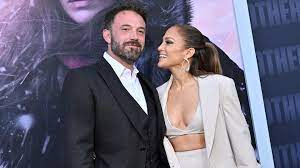
Michael B Jordan's Career and Net Worth
Michael B. Jordan is an American actor and producer who has established himself as one of the most talented and sought-after actors in Hollywood. His career began in television, with early roles on shows such as "The Sopranos" and "The Wire." He gained widespread recognition for his role as Vince Howard on the television series "Friday Night Lights."
Jordan's breakthrough role came in 2013 when he starred in the critically acclaimed film "Fruitvale Station." The film, which was based on the true story of Oscar Grant, received positive reviews and was a commercial success. Jordan's performance earned him widespread praise and helped establish him as a rising star in the film industry.
In 2015, Jordan starred as Adonis Creed in the "Rocky" spinoff film "Creed," which was also a box office success. He reprised the role in the sequel, "Creed II," which was released in 2018. Jordan's portrayal of Adonis Creed helped to establish him as a leading man in Hollywood.
Jordan's involvement in the Marvel Cinematic Universe also contributed to his rise in fame and wealth. He played the villain Erik Killmonger in the 2018 blockbuster "Black Panther," which was a critical and commercial success, grossing over $1 billion worldwide. Jordan's performance was widely praised, and his role in the film helped to further establish him as a major force in Hollywood.
In addition to his acting work, Jordan has also ventured into producing. He has produced several films and television shows, including the Netflix series "Raising Dion." He also has various endorsement deals with brands such as Coach, Piaget, and Amazon Studios.
As of 2021, Michael B. Jordan's net worth is estimated to be approximately $25 million. His net worth is a testament to his success and talent in the entertainment industry. Despite facing some challenges and criticism throughout his career, he has continued to work hard and take on challenging roles that showcase his range and versatility as an actor. With many more exciting projects on the horizon, it's likely that his net worth will continue to rise in the years to come.
Inside Michael B Jordan's Lavish Lifestyle
Michael B. Jordan's lavish lifestyle is a reflection of his success in the entertainment industry and his personal taste. He has a net worth of approximately $25 million and has not been shy about spending his wealth on luxurious homes, cars, fashion, and travel.
One of Jordan's most notable purchases was a 4,672 square-foot mansion in the Sherman Oaks neighborhood of Los Angeles. The house, which he purchased for $5.8 million in 2019, features a modern design with an open floor plan, high ceilings, a movie theater, a pool, and a spa.
Jordan is also a fan of luxury cars and has been spotted driving a number of high-end vehicles, including a Mercedes-Benz SLS AMG, a BMW i8, and a Lamborghini Huracán. He has also been known to wear expensive clothing from designer brands such as Louis Vuitton, Givenchy, and Off-White.
When it comes to travel, Jordan has been known to indulge in luxury vacations. He has been spotted vacationing in exotic destinations such as Italy, Mexico, and Greece. He also took a trip to Tokyo, Japan in 2019, where he was photographed in front of the iconic Tokyo Tower.
Despite his lavish lifestyle, Jordan is also known for his philanthropic work. He has been involved in various charitable organizations and has used his platform to raise awareness for social and environmental issues. In 2020, he launched the #ChangeHollywood initiative, which aims to increase diversity and representation in the entertainment industry.
Overall, Michael B. Jordan's lavish lifestyle is a reflection of his success and personal taste. He has worked hard to achieve his success and has not been afraid to spend his wealth on the things he enjoys. Despite his luxurious lifestyle, he has also been known to give back to his community and use his platform for good causes.
1 note
·
View note
Text

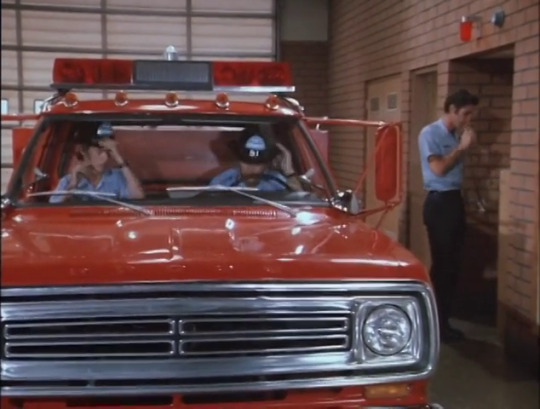
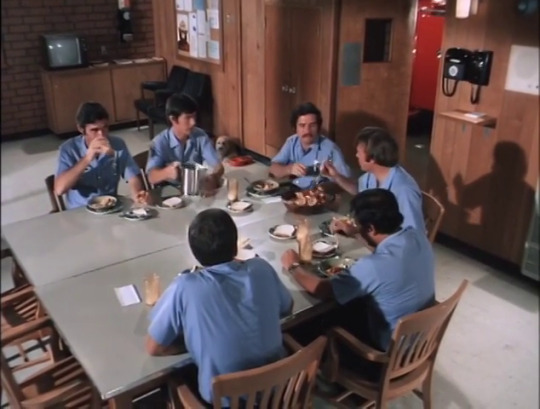
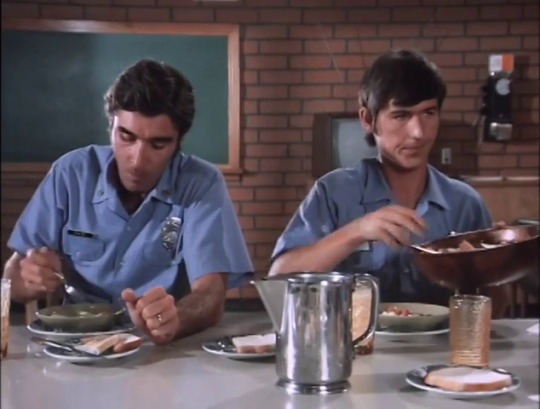

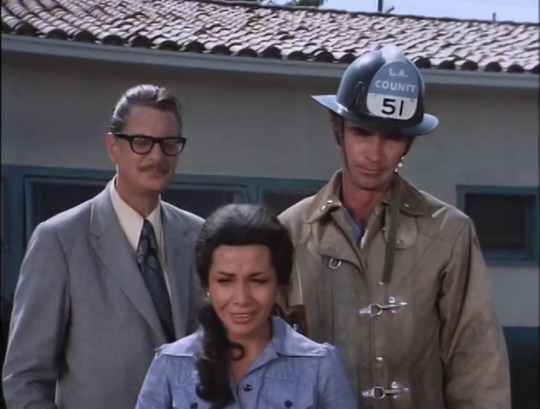
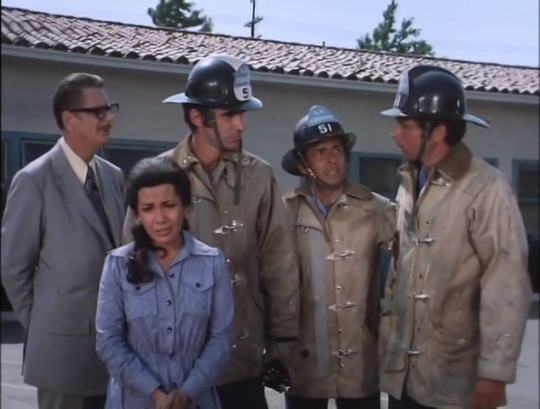
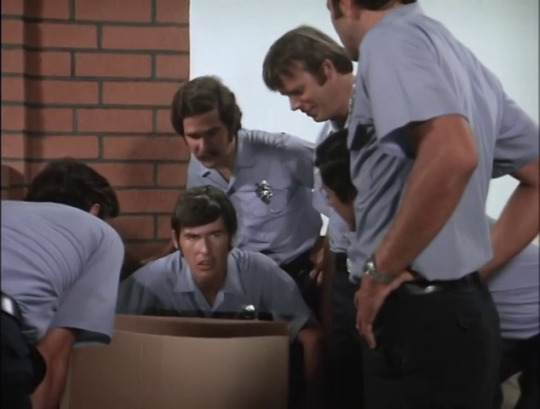


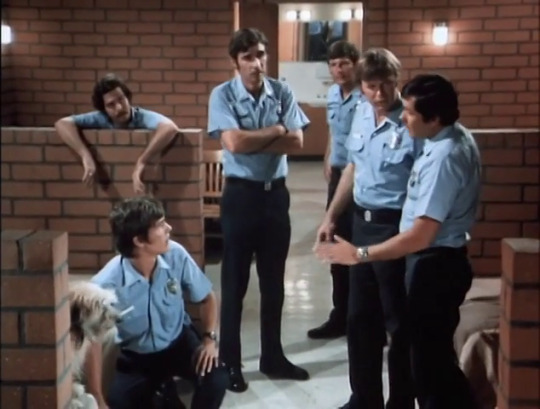
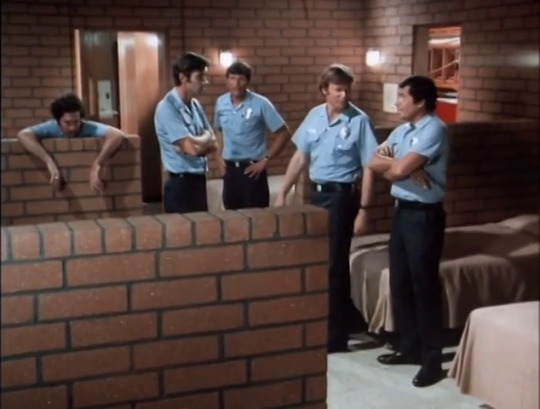
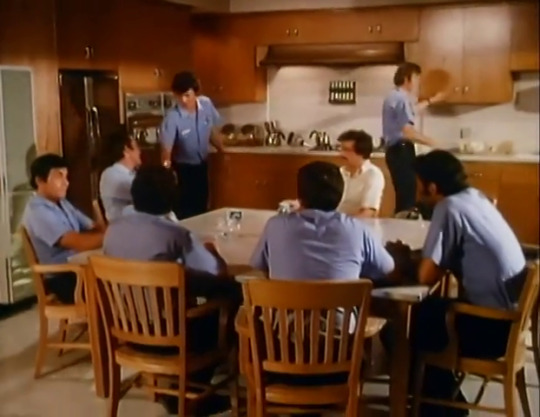

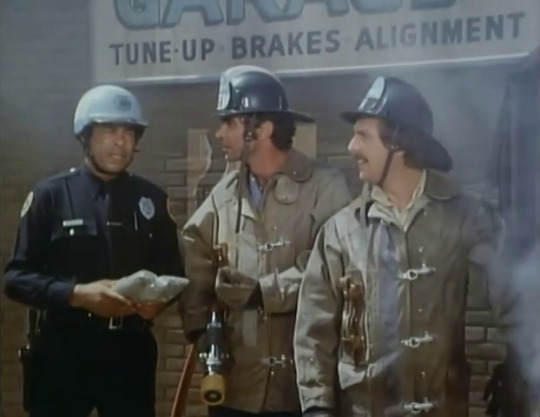

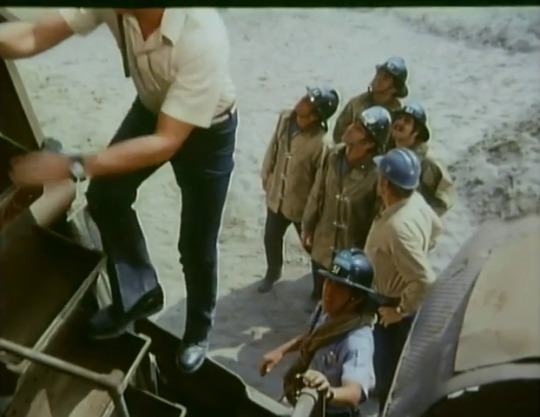
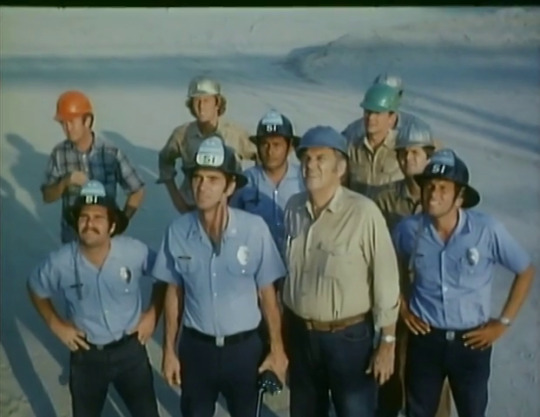
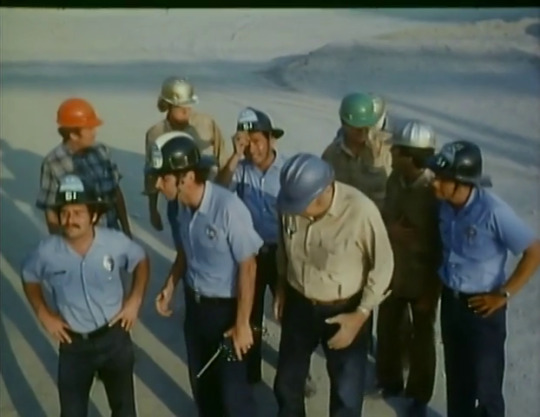
Hey guys,
time to update again and it's time for Cap again.
Still covering two episodes, yet at one point I might reduce to one only. As said before, depending on the episode and my shots. ;-)
Enjoy!
#oldtv's e! snapshots#emergency!#johnny gage#roy desoto#station 51#captain hank stanley#chet kelly#marco lopez#mike stoker#s03e03#s03e04#officer vince howard#firefighter jason channing#pio dick friend#i miss cap!#enjoy!
16 notes
·
View notes
Text
My 25 Favorite Films of 2020
Well, this was quite the crazy year, especially for movies. While many films that were slated to be released this year were postponed due to the coronavirus pandemic, this year still provided some laughs, tears, and thrills both in theaters and in the living room.
(NOTE: Due to the delayed awards season calendar and postponed Oscar bait films that are unavailable to be seen before the end of 2020, this list will eventually be updated after having seen the following films: The Father, Minari, News of the World, Nomadland, One Night in Miami, Pieces of a Woman, Promising Young Woman)
Here are my 25 favorite films of the year:
25. Kajillionaire
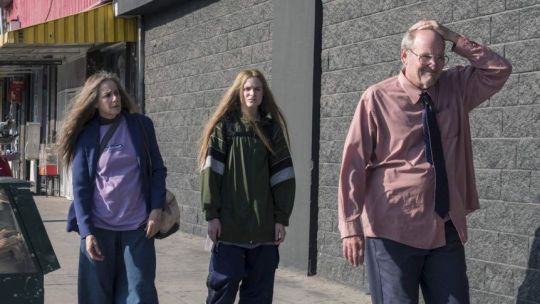
Quirky filmmaker Miranda July is back with her first feature in nearly a decade. Kajillionaire is a bizarre but captivating tale about a family of criminal grifters and how the daughter reevaluates her strained relationship with her parents after an outsider is welcomed into the fold. Evan Rachel Wood takes what could have easily been dismissed as a goofy caricature in Old Dolio (yes, that’s her name) and turns into a heartfelt portrayal of a woman whose lifestyle of freeloading dictated by her parents (played by Debra Winger and Richard Jenkins) becomes her own crisis. In many ways, Kajillionaire feels like a fantasy that keeps people asking, “What on earth is going on?” And this time, it’s for the best.
24. Freaky

Revamping decades-old plots like the body-swapping antics from Freaky Friday can either result in a predictable failure or a surprising success. Thankfully, Freaky falls into the latter category. In this horror comedy, a deranged serial killer (played by Vince Vaughn) swaps bodies with his victim, a timid teen girl (played by Kathryn Newton). What makes the film work though are the dedicated lead performances, particularly by Vaughn, who is pretty convincing as young girl trapped in a grown man’s body. With a few good laughs and decent thrills, Freaky is worth the watch.
23. The Outpost

The Outpost is an intense film about the real-life story of small group of US troops isolated by surrounding mountains in Afghanistan, under the constant threat of the Taliban, which ultimately comes to a head in the Battle of Kamdesh. The film captures the harrowing experiences of these soldiers with heart-pounding action sequences, which are fueled by a solid cast including Scott Eastwood, Caleb Landry Jones, and Orlando Bloom.
22. Uncle Frank

Paul Bettany may be best known for playing The Vision in the Marvel Cinematic Universe, but he should be celebrated as his title character in Uncle Frank, a touching dramedy set in 1973 about an NYU professor who returns home to his estranged family for his father’s funeral while his niece, played by rising star Sophia Lillis, idolizes him for teaching her to be her authentic self while he keeps his sexuality a secret. Bettany brilliantly balances the coolness of his stature with the internal agony that ultimately hits a boiling point, which is counterbalanced by Peter Macdissi’s fun performance as Frank’s happy-go-lucky lover who accompanies him back home despite his wishes.
21. Hillbilly Elegy
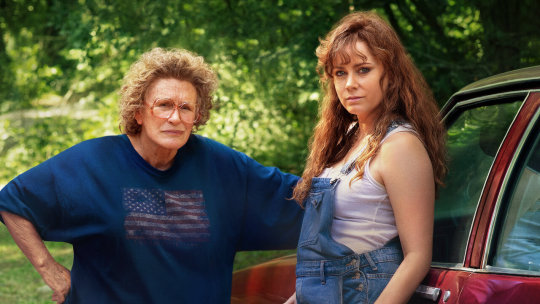
Hillbilly Elegy was panned by critics over politics that had absolutely no role the film. Based on the best-selling memoir by J.D. Vance, the newest feature from Ron Howard shows the journey of a boy who despite all odds growing up in a poor family that constantly struggled with abuse and addition managed to get into Yale Law School and achieve the American dream. While both Gabriel Basso and Owen Asztalos hold the film together as the younger and older Vance in the present and flashback scenes, Amy Adams as the impulsive, irresponsible mother and an unrecognizable Glenn Close as the no-nonsense inspiring grandmother that turn Hillbilly Elegy into an acting tour de force.
20. The Trial of the Chicago 7

Oscar-winning screenwriter Aaron Sorkin sits in the director’s chair once again in this courtroom drama about the real-life protesters who showed up in Chicago during the 1968 Democratic National Convention. With themes that resonate today, The Trial of the Chicago 7 benefits from its sharp screenplay, well-paced editing, and an outstanding ensemble cast that includes Eddie Redmayne, Mark Rylance, Yahoo Abdul-Mateen II, Sacha Baron Cohen, Jeremy Strong, Frank Langella, Joseph Gordon-Levitt, and Michael Keaton.
19. Yellow Rose

Broadway actress Eva Noblezada makes her film debut as an aspiring country singer on the run after her mother, an illegal immigrant, is obtained for deportation. Yellow Rose presents a nuanced depiction of US immigration, but at the heart of it is a heartbreaking story of a young woman who struggles between putting her family or her dreams first. Between Noblezada’s powerful performance and solid original music, Yellow Rose hits all the right chords.
18. Palm Springs
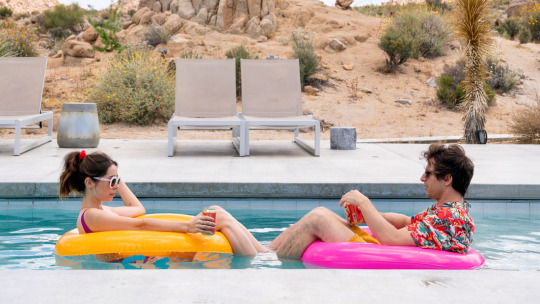
Move over, Groundhog Day. While the Bill Murray classic has largely monopolized the time loop film genre, Palm Springs gives it a run for its money. Andy Sandberg and Cristin Milioti star as the unlikely duo who are stranded reliving the same dreaded wedding day involving mutual acquaintances and their desperate efforts to escape the seemingly inescapable. The Hulu comedy stands on its own two feet for the good laughs, the chemistry between the two leads, and the film’s emotionally-grounded plot.
17. Let Him Go

Kevin Costner and Diane Lane reunite on the big screen after playing farmer parents in Man of Steel to rancher grandparents in Let Him Go, although this time they are able to display their full acting chops. In this period dramatic thriller, they set out to find their only grandchild following the death of their son only to discover that the widowed daughter-in-law remarried into an infamous crime family. While both Costner and Lane tug at the heartstrings, it’s Lesley Manville, who plays the ruthless matriarch of the family, that really takes command of the screen. Ultimately, Let Him Go is all about family and the lengths one is willing to go to protect it.
16. Unhinged

In a year plagued by the pandemic, Unhinged led the way to the revival of movie theaters back in August and perhaps in some ways it was meant to be the film to do so as the themes of a rage-fueled society and the lack of human connection carry weight. Russell Crowe stars, as the title suggests, as an unhinged psychopath whose road rage torments a woman and her adolescent son. Unhinged is the epitome of pure entertainment and is why we go to the movies. While it’s not quite the most sophisticated thriller of the year, it’s still one helluva ride.
15. Emma

Anya Taylor-Joy has had quite the year with both highs (The Queen’s Gambit) and lows (The New Mutants). But it began before the pandemic with the release of Emma, which she stars as the iconic Jane Austen title character, a socialite who meddles in the love life of others while refusing to acknowledge her own shortcomings in that department. Supported with a strong ensemble cast, beautiful production design, and comedic charm, Emma is not to be missed.
14. The Invisible Man

ln the era of remakes and reboots, very few are as good as Universal’s latest monster flick revival of The Invisible Man. Elisabeth Moss stars as a woman who believes she’s being haunted by her abusive ex-husband, someone she becomes convinced faked his own death and is stalking her without being able to be seen. Filmmaker Leigh Whannell, the writer behind the Saw and Insidious horror franchises, generates good thrills and high-wire tension with the help of high production value and a terrifyingly-good performance from Moss.
13. Dick Johnson is Dead

Documentarian Kirsten Johnson filmed a beautiful, intimate tribute to her father Dick Johnson, who has been suffering from Alzheimer's in the final years of his life. However, instead of dreading his death, both daughter and father embrace it by having him acting out several scenes of his over-the-top demises. Dick Johnson is Dead may focus on the subject manner of death, but this documentary actually celebrates life and the laughs that happen along the way.
12. The Wolf of Snow Hollow
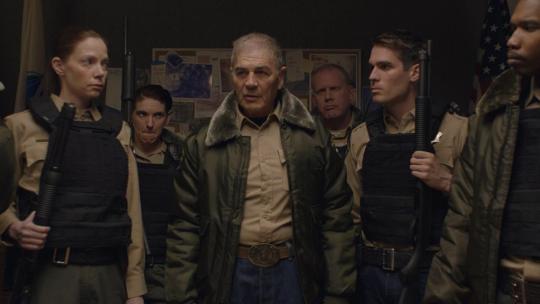
Perhaps one of the littlest-known films of the year, The Wolf of Snow Hollow is not your conventional indie comedy horror flick. Writer/director Jim Cummings stars as an overly-heated police officer who attempts to get to the bottom of a string of murders in his small, snowy Utah town by what appears to be some sort of werewolf, though he remains unconvinced. Featuring one of the final performances from veteran actor Robert Forster, The Wolf of Snow Hollow uses its quirky sense of humor to stand out from the rest of the pack.
11. The Gentlemen

The Gentlemen is a fun, action-packed, crime caper from Guy Ritchie about the London turf war of drug kingpins. Matthew McConaughey, Charlie Hunnam, Henry Goulding, Michelle Dockery, and Colin Ferrell all round out the strong cast, but its Hugh Grant that really steals the show as the comedically manipulative Fletcher, whose only allegiance is to himself. If you like a stylish film with well-choreographed violence and a fast-paced plot, The Gentlemen should be your cup of tea.
10. Ma Rainey’s Black Bottom

Some of the best play-to-film adaptations are the films that feel like you’re watching a play, and Ma Rainey’s Black Bottom is one of them. Produced by Denzel Washington, Viola Davis gives a transformative performance as Ma Rainey, known as the “mother of the blues” and the clash she had with a pair of White music producers, but she also butts heads with her trumpet player (played by the late Chadwick Boseman), who also has his own music ambitions. While Davis obviously gives other Oscar-worthy performance, it was Boseman who was able to show how incredibly gifted he was as an actor. And while the world lost him far too soon, at least his last role ended up being his greatest.
9. The Kid Detective
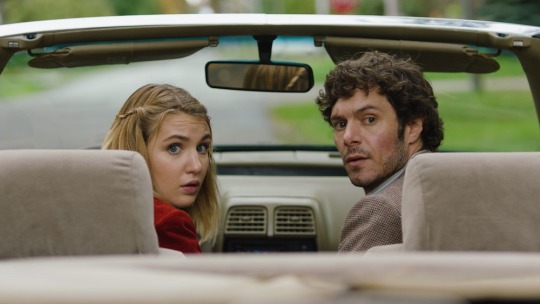
One of the biggest surprises of the year was how good a movie starring and produced by Adam Brody was. Brody plays a washed up former kid detective who attempts to revive his once-celebrated career of solving mysteries by getting to the bottom of a murder in his hometown. The Kid Detective is a brilliant dark comedy from newcomer writer/director Evan Morgan with good laughs, plenty of plot twists, and a career-best performance from Brody, who proves he’s more than just the pretty face from The O.C. we all know him as.
8. Mank

Citizen Kane is widely regarded as one of the greatest films ever made and Mank is a worthy tribute. Gary Oldman stars as the title character Herman “Mank” Mankiewicz, the Oscar-winning screenwriter behind the iconic film. David Fincher (The Social Network, Gone Girl) managed to capture the epic scale of the 1941 classic that would make Orson Welles proud.
7. Soul
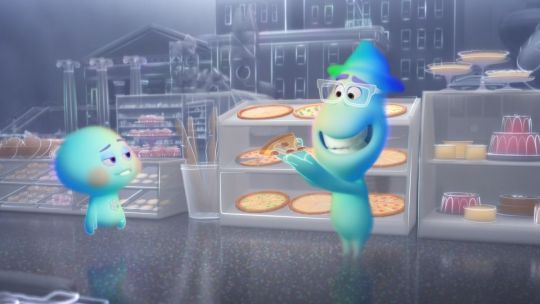
Soul is one of those rare existential Pixar films that goes beyond being children’s entertainment. Following in the footsteps of 2015′s Inside Out, Soul depicts what happens to the soul of a jazz musician who’s convinced his time on Earth isn’t over. While the universe created to explain how souls work and the plot that went along with it falls short of its emotions predecessor, Soul is still high-caliber among Pixar films and a great movie for both kids and adults alike.
6. Another Round

Perhaps the greatest work from Swedish director Thomas Vinterberg to date, Another Round follows four unsatisfied middle aged men who decide to take a theory of task from a Norwegian psychiatrist, who concluded that maintaining a blood alcohol level of 0.050 will enhance their mental and psychological state. Mads Mikkelsen, who’s best known to American audiences as Hannibal Lecter in the short-lived NBC series Hannibal and the Bond villain in Casino Royale, offers a strong, nuanced performance as one of the four educators who embraces this drinking challenge in a film that provides an equal balance of chuckles, cringes, and emotional gut punches.
5. I’m Thinking of Ending Things

From the crazy mastermind of Charlie Kaufman, the writer behind Being John Malkovich, Eternal Sunshine of the Spotless Mind, and Anomalisa, his latest on Netflix is too a mind-bender. I’m Thinking of Ending Things is a surreal, zany, and at times disturbing examination of the human condition as the nameless female protagonist played by an incredible Jessie Buckley mulls over breaking up with her boyfriend (played by Jesse Plemons) while visiting his parents’ house. Accompanied with a stellar production design and a crazy-good performance from Toni Collette as “Mother,” Kaufman newest cerebral feature lives up to his iconic reputation of filmmaking.
4. Da 5 Bloods

Spike Lee is one of the few genius filmmakers who is able to blend multiple genres together and his latest film is no different. Da 5 Bloods is an action adventure, buddy comedy, dramatic character study, and war movie all wrapped up into one about a group of Vietnam War veterans who return to the former battlegrounds to find the remains of one of their fallen soldiers as well as some treasure that they kept hidden years ago. With a strong ensemble cast that includes the late Chadwick Boseman, its longtime character actor Delroy Lindo who steals the show with his powerful performance. Da 5 Bloods is easily one of Netflix’s strongest films to date.
3. The Assistant
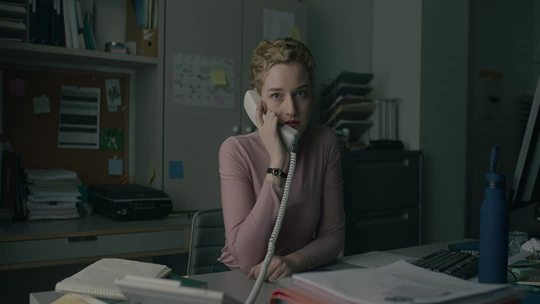
One of the first #MeToo-era films, The Assistant offers the day in the life of a low-level female staffer of a production company who is haunted by the presence of her Harvey Weinstein-like boss (who never actually appears in the film). However, rather than depicting the dramatics of sexual misconduct, The Assistant uses the common subtleties and nuances of the workplace yet maintains the same tension and heartbreak. Anchored by the remarkable, devastating performance by up-and-comer Julia Garner (Ozark), The Assistant is as important as it is well-done.
2. Sound of Metal

Riz Ahmed gives the performance of his career as a heavy metal drummer and former addict whose sudden battle with going deaf upends his life. Sound of Metal is an incredible experience that gives a rare glimpse in the American deaf community which is enhanced by the remarkable sound design that helps the audience actually hear what the musician is going through. It’s truly one of the most rewarding films of the year.
1. The Climb
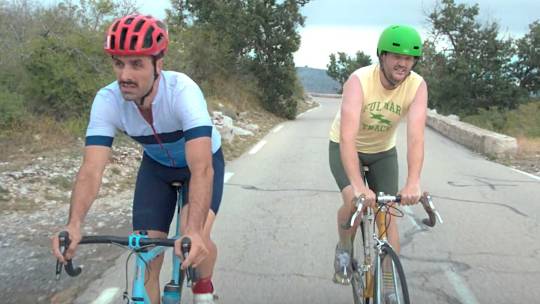
The Climb takes the generic “man sleeps with his best friend’s fiancé” storyline and turns it on its head. In his feature debut as writer and director, Michael Angelo Covino leads as the not-so-apologetic adulterer Mike and Kyle Marvin, who co-wrote the film, is the good-hearted Kyle who struggles to whether or not to forgive his best friend’s ultimately betrayal. Not only is The Climb is quirky and hilariously written, it’s a remarkably well-made comedy with some of the year’s best cinematography. Between a strong cast, a superb screenplay, and the extremely-high production value, The Climb is at the top of the mountain of 2020′s best films.
#The Climb#2020#Soul#riz ahmed#kajillionaire#Da 5 Bloods#Spike Lee#Pixar#I’m Thinking of Ending Things#jessie buckley#The Kid Detective#Adam Brody#Emma#The Queen's Gambit#Unhinged#Elisabeth Moss#Palm Springs#Netflix#ma rainey's black bottom#Chadwick Boseman#viola davis#Uncle Frank#Yellow Rose#Eddie Redmayne#joseph gordon-levitt#Hillbilly Elegy#Amy Adams#Glenn Close#Matthew McConaughey#Jamie Foxx
432 notes
·
View notes
Text
The Mighty Boosh on the business of being silly
The Times, November 15 2008
What began as a cult cocktail of daft poems, surreal characters and fantastical storylines has turned into the comedy juggernaut that is the Mighty Boosh. Janice Turner hangs out with creators Noel Fielding, Julian Barratt and the extended Boosh family to discuss the serious business of being silly
In the thin drizzle of a Monday night in Sheffield, a crowd of young women are waiting for the Mighty Boosh or, more precisely, one half of it. Big-boned Yorkshire lasses, jacketless and unshivering despite the autumn nip, they look ready to devour the object of their desire, the fey, androgynous Noel Fielding, if he puts a lamé boot outside the stage door. “Ooh, I do love a man in eyeliner,” sighs Natalie from Rotherham. She’ll be throwing sickies at work to see the Boosh show 13 times on their tour, plus attend the Boosh after-show parties and Boosh book signings. “My life is dead dull without them,” she says.
Nearby, mobiles primed, a pair of sixth-formers trade favourite Boosh lines. “What is your name?” asks Jessica. “I go by many names, sir,” Victoria replies portentously. A prison warden called Davena survives long days with high-security villains intoning, “It’s an outrage!” in the gravelly voice of Boosh character Tony Harrison, a being whose head is a testicle.
Apart from Fielding, what they all love most about the Boosh is that half their mates don’t get it. They see a bloke in a gorilla suit, a shaman called Naboo, silly rhymes about soup, stories involving shipwrecked men seducing coconuts “and they’re like, ‘This is bloody rubbish,’” says Jessica. “So you feel special because you do get it. You’re part of a club.”
Except the Mighty Boosh club is now more like a movement. What began as an Edinburgh fringe show starring Fielding and his partner Julian Barratt and later became an obscure BBC3 series has grown into a box-set flogging, mega-merchandising, 80-date touring Boosh inc. There was a Boosh festival last summer, now talk of a Boosh movie and Boosh in America. An impasse seems to have been reached: either the Boosh will expand globally or, like other mass comedy cults before it – Vic and Bob, Newman and Baddiel – slowly begin to deflate.
But for the moment, the fans still wait in the rain for heroes who’ve already left the building. I find the Boosh gang gathered in their hotel bar, high on post-gig adrenalin. Barratt, blokishly handsome with his ring-master moustache, if a tad paunchy these days, blends in with the crew. But Fielding is never truly “off”. All day he has been channelling A Clockwork Orange in thick black eyeliner (now smudged into panda rings) and a bowler hat, which he wears with polka-dot leggings, gold boots and a long, neon-green fur-collared PVC trenchcoat. He has, as those women outside put it, “something about him”: a carefully-wrought rock-god danger mixed with an amiable sweetness. Sexy yet approachable. Which is why, perched on a barstool, is a great slab of security called Danny.
“He stops people getting in our faces,” says Fielding. “He does massive stars like P. Diddy and Madonna and he says that considering how we’re viewed in the media as a cult phenomenon, we get much more attention in the street than, say, Girls Aloud. Danny says we’re on the same level as Russell Brand, who can’t walk from the door to the car without ten people speaking to him.”
This barometer of fame appears to fascinate and thrill Fielding. Although he complains he can’t eat dinner with his girlfriend (Dee Plume from the band Robots in Disguise) unmolested, he parties hard and publicly with paparazzi-magnets like Courtney Love and Amy Winehouse. He claims he’s tried wearing a baseball cap but fans still recognise him. Hearing this, Julian Barratt smiles wryly: “Noel is never going to dress down.”
It is clear on meeting them that their Boosh characters Vince Noir (Fielding), the narcissistic extrovert, and Howard Moon (Barratt), the serious, socially awkward jazz obsessive, are comic exaggerations of their own personalities. At the afternoon photo shoot, Fielding breaks free of the hair and make-up lady, sprays most of a can of Elnett on to his Bolan feather-cut and teases it to his satisfaction. Very Vince. “It is an art-life crossover,” says Barratt.
At 40, five years older than Fielding, Barratt exhibits the profound weariness of a man trying to balance a five-month national tour with new-fatherhood. After every Saturday night show he returns home to his 18-month-old twins, Arthur and Walter, and his partner Julia Davis (the creator-star of Nighty Night) and today he was up at 5am pushing a pram on Hampstead Heath before taking the train north to rejoin the Boosh. “I go back so the boys remember who I am. But it’s harder to leave them every time,” he says. “It is totally schizophrenic, totally opposite mental states: all this self-obsession and then them.”
About two nights a week on tour, Fielding doesn’t go to bed, parties through the night and performs the next evening having not slept at all. Barratt often retreats to his room to plough through box sets of The Wire. “It’s a bit gritty, but that is in itself an escape, because what we do is so fantastical.”
But mostly it is hard to resist the instant party provided by a large cast, crew and band. Indeed, drinking with them, it appears Fielding and Barratt are but the most famous members of a close collective of artists, musicians and old mates. Fielding’s brother Michael, who previously worked in a bowling alley, plays Naboo the shaman. “He is late every single day,” complains Noel. “He’s mad and useless, but I’m quite protective of him, quite parental.” Michael is always arguing with Bollo the gorilla, aka Fielding’s best mate, Dave Brown, a graphic artist relieved to remove his costume – “It’s so hot in there I fear I may never father children” – to design the Boosh book. One of the lighting crew worked as male nanny to Barratt’s twins and was in Michael’s class at school: “The first time I met you,” he says to Noel, “you gave me a dead arm.” “You were 9,” Fielding replies. “And you were messing with my stuff.”
This gang aren’t hangers-on but the wellspring of the Boosh’s originality and its strange, homespun, degree-show aesthetic: a character called Mr Susan is made out of chamois leathers, the Hitcher has a giant Polo Mint for an eye. When they need a tour poster they ignore the promoter’s suggestions and call in their old mate, Nige.
Fielding and Barratt met ten years ago at a comedy night in a North London pub. The former had just left Croydon Art College, the latter had dropped out of an American Studies degree at Reading to try stand-up, although he was so terrified at his first gig that he ran off stage and had to be dragged back by the compere.
While superficially different, their childhoods have a common theme: both had artistic, bohemian parents who exercised benign neglect. Fielding’s folks were only 17 when he was born: “They were just kids really. Hippies. Though more into Black Sabbath and Led Zep. There were lots of parties and crazy times. They loved dressing up. And there was a big gap between me and my brother – about nine years – so I was an only child for a long time, hanging out with them, lots of weird stuff going on.
“The great thing about my mum and dad is they let me do anything I wanted as a kid as long as I wasn’t misbehaving. I could eat and go to bed when I liked. I used to spend a lot of time drawing and painting and reading. In my own world, I guess.”
Growing up in Mitcham, South London, his father was a postmaster, while his mother now works for the Home Office. Work was merely the means to fund a good time. “When your dad is into David Bowie, how do you rebel against that? You can’t really. They come to all the gigs. They’ve been in America for the past three weeks. I’m ringing my mum really excited because we’re hanging out with Jim Sheridan, who directed In the Name of the Father, and the Edge from U2, and she said, ‘We’re hanging with Jack White,’ whom they met through a friend of mine. Trumped again!”
Barratt’s father was a Leeds art teacher, his mother an artist later turned businesswoman. “Dad was a bit more strict and academic. Mum would let me do anything I wanted, didn’t mind whether I went to school.” Through his father he became obsessed with Monty Python, went to jazz and Spike Milligan gigs, learnt about sex from his dad’s leatherbound volumes of Penthouse.
Barratt joined bands and assumed he would become a musician (he does all the Boosh’s musical arrangements); Fielding hoped to become an artist (he designed the Boosh book cover and throughout our interview sketches obsessively). Instead they threw their talents into comedy. Barratt: “It is a great means of getting your ideas over instantly.” Fielding: “Yes, it is quite punk in that way.”
Their 1998 Edinburgh Fringe show called The Mighty Boosh was named, obscurely, after a friend’s description of Michael Fielding’s huge childhood Afro: “A mighty bush.” While their double-act banter has an old-fashioned dynamic, redolent of Morecambe and Wise, the show threw in weird characters and a fantasy storyline in which they played a pair of zookeepers. They are very serious about their influences. “Magritte, Rousseau...” says Fielding. “I like Rousseau’s made-up worlds: his jungle has all the things you’d want in a jungle, even though he’d never been in one so it was an imaginary place.”
Eclectic, weird and, crucially, unprepared to compromise their aesthetic sensibilities, it was 2004 before, championed by Steve Coogan’s Baby Cow production company, their first series aired on BBC3. Through repeats and DVD sales the second series, in which the pair have left the zoo and are living above Naboo’s shop, found a bigger audience. Last year the first episode of series three had one million viewers. But perhaps the Boosh’s true breakthrough into mainstream came in June when George Bush visited Belfast and a child presented him with a plant labelled “The Mighty Bush”. Assuming it was a tribute to his greatness, the president proudly displayed it for the cameras, while the rest of Britain tittered.
A Boosh audience these days is quite a mix. In Sheffield the front row is rammed with teenage indie girls, heavy on the eyeliner, who fancy Fielding. But there are children, too: my own sons can recite whole “crimps” (the Boosh’s silly, very English version of rap) word for word. And there are older, respectable types who, when I interview them, all apologise for having such boring jobs. They’re accountants, IT workers, human resources officers and civil servants. But probe deeper and you find ten years ago they excelled at art A level or played in a band, and now puzzle how their lives turned out so square. For them, the Boosh embody their former dreams. And their DIY comedy, shambolic air, the slightly crap costumes, the melding of fantasy with the everyday, feels like something they could still knock up at home.
Indeed, many fans come to gigs in costume. At the Mighty Boosh Festival 15,000 people came dressed up to watch bands and absurdity in a Kent field. And in Sheffield I meet a father-and-son combo dressed as Howard Moon and Bob Fossil – general manager of the zoo – plus a gang of thirty-something parents elaborately attired as Crack Fox, Spirit of Jazz, a granny called Nanageddon, and Amy Housemouse. “I love the Boosh because it’s total escapism,” says Laura Hargreaves, an employment manager dressed as an Electro Fairy. “It’s not all perfect and people these days worry too much that things aren’t perfect. It’s just pure fun.”
But how to retain that appealingly amateur art-school quality now that the Boosh is a mega comedy brand? Noel Fielding is adamant that they haven’t grown cynical, that The Mighty Book of Boosh was a long-term project, not a money-spinner chucked out for Christmas: “There is a lot of heart in what we do,” he says. Barratt adds: “It’s been hard this year to do everything we’ve wanted, to a standard we’re proud of... Which is why we’re worn to shreds.”
Comedy is most powerful in intimate spaces, but the Boosh show, with its huge set, requires major venues. “We’ve lost money every day on the tour,” says Fielding. “The crew and the props and what it costs to take them on the road – it’s ridiculous. Small gigs would lose millions of pounds.”
The live show is a kind of Mighty Boosh panto, with old favourites – Bob Fossil, Bollo, Tony Harrison, etc – coming on to cheers of recognition. But it lacks the escapism to the perfectly conceived world of the TV show. They have told the BBC they don’t want a fourth series: they want a movie. They would also, as with Little Britain USA, like a crack at the States, where they run on BBC America. Clearly the Boosh needs to keep evolving or it will die.
Already other artists are telling Fielding and Barratt to make their money now: “They say this is our time, which is quite frightening.” I recall Vic Reeves and Bob Mortimer, who dominated the Nineties with Big Night Out and Shooting Stars. “Yes, they were massive,” says Fielding. “A number one record...” And now Reeves presents Brainiac. “If you have longer-term goals, it’s not scary,” says Barratt. “To me, I’m heading somewhere else – to direct, make films, write stuff – and at the moment it’s all gone mental. I’m sort of enjoying this as an outsider. It was Noel who had this desire to reach more people.”
Indeed, the old cliché that comedy is the new rock’n’roll is closest to being realised in Noel Fielding. Watching him perform the thrash metal numbers in the Boosh live show, he is half ironic comic performer, half frustrated rock god. His heroes weren’t comics but androgynous musicians: Jagger, Bowie, Syd Barrett. (Although he liked Peter Cook’s style and looks.)
“I like clothes and make-up, I like the transformation,” he says. Does it puzzle him that women find this so sexually attractive? “I was reading a book the other day about the New York Dolls and David Johansen was saying that none of them were gay or even bisexual, and that when they started dressing in stilettos and leather pants, women got it straight away with no explanation. But a lot of men had problems. It’s one of those strange things. A man will go, ‘You f***ing queer.’ And you just think, ‘Well, your girlfriend fancies me.’”
The Boosh stopped signing autographs outside stage doors when it started taking two hours a night. At recent book signings up to 1,500 people have shown up, some sleeping overnight in the queue. And on this tour, the Boosh took control of the after-show parties, once run as money-spinners by the promoters, and now show up in person to do DJ slots. I ask if they like to meet their fans, and they laugh nervously.
Fielding: “We have to be behind a fence.”
Barratt: “They try to rip your clothes off your body.”
Fielding: “The other day my girlfriend gave me this ring. And, doing the rock numbers at the end, I held out my hands and the crowd just ripped it off.”
Barratt: “I see it as a thing which is going to go away. A moment when people are really excited about you. And it can’t last.”
He recalls a man in York grabbing him for a photo, saying, “I’d love to be you, it must be so amazing.” And Barratt says he thought, “Yes, it is. But all the while I was trying to duck into this doorway to avoid the next person.” He’s trying to enjoy the Boosh’s moment, knows it will pass, but all the same?
In the hotel bar, a young woman fan has dodged past Danny and comes brazenly over to Fielding. Head cocked attentively like a glossy bird, he chats, signs various items, submits to photos, speaks to her mate on her phone. The rest of the Boosh crew eye her steelily. They know how it will end. “You have five minutes then you go,” hisses one. “I feel really stupid now,” says the girl. It is hard not to squirm at the awful obeisance of fandom. But still she milks the encounter, demands Fielding come outside to meet her friend. When he demurs she is outraged, and Danny intercedes. Fielding returns to his seat slightly unsettled. “What more does she want?” he mutters, reaching for his wine glass. “A skin sample?”
#I hadn't seen this one before so I thought I'd share#noel will never dress down#ah yes the patient boyfriend Julian Barratt
36 notes
·
View notes
Text
Never written Mighty Boosh plotline:
The terrifying true tale of the tooth fairy
Vince and Howard get somehow sucked/zapped/poofed in to the realm of the tooth fairy. (Perhaps Vince wore an amulet made of unicorn teeth to their latest failed gig, stolen from Naboo obviously.)
The realm of the Tooth Fairy appears to be made of gaff tape, cardboard, props from dentists’ offices, and a projector screen. Neither Howard nor Vince are impressed. Howard proceeds to have a mini-breakdown over their predicament.
He is interrupted by a scream and the sound of flapping wings. Something loud, heavy, and American, falls on him. Vince is unharmed and amused. What they think is the tooth fairy is Bob Fossil in wings and a tutu and not much else. Vince and Howard mutually agree never to discuss what they see when Fossil fairy bends over.
But then they find out that Fossil fairy is just the “face” of the tooth fairy. He’s just the front man so the kids don’t freak out. What could be more terrifying than a Fossilesque Tooth Fairy your ask?
At which moment the real tooth fairy appears, made entirely of teeth, moving like a hideous jumble of barely controlled limbs, a puppet with uneven strings. The teeth grind as it moves and immediately set Howard’s own teeth on edge. The Tooth Fairy wants its amulet back but Vince doesn’t part with accessories easily and argues that a tooth necklace would just clash with everything else the Tooth Fairy is wearing... and made of.
Now it is time to run. There is musics. It has been written by Julian Barratt. It is good. The music fades as Howard and Vince approach a dead end. They hold hands. They scream. Howard valiantly attempts to save them and squirts the Tooth Fairy with his water gun filled with mouth wash but it just makes the fairy stronger.
Vince pulls out his bag of Saturn zingers and flings them at him. They burn. He dumps potato crisps on him, they eat away at him and get stuck in hard to reach places. Potato crisps are bad like that.
Vince then pulls from his back pocket (where was he keeping that thing? He’s wearing a catsuit!) a jumbo sized Starbucks Unicorn Frappuccino, takes a sip, winks at the camera, and tosses the sugar filled beverage at the monster. Said monster proceeds to scream and steam and melt, dying with a gurgle and the words “I’ll get you my pretty, and your little dog too!” though most of this is drowned out by Fossil Fairy who tells him to shut up because that line is copyrighted and they can’t afford it.
The Fossil Fairy thanks them for freeing him from his tyrannical boss, who never paid him any extra for working nights and weekends, and then looks angrily at the two, stamping his foot impatiently. When are they going to kiss already? He even presses play on a cassette player and the ‘romantic music’ begins to play. Vince and Howard just look at him blankly and so in a huff the Fossil Fairy snaps his fingers, sending them back to their world, but grabbing hold of the tooth amulet in the process. He chuckles in a slightly malevolent way.
Meanwhile Vince and Howard end up back in their world, but naked, in bed together. They look at each other in shock and silent embarrassment until Vince looks up at Howard meaningfully. “Howard? There’s something I have to tell you, Howard...” Howard scoots closer, an amorous look in his eyes. “Howard, I don’t know how to tell you this but... I think there’s something underneath my pillow.”
THE END!
#the mighty boosh#mighty boosh#mighty boosh fanfic#tmb#vince noir#howard moon#my writing#boosh thoughts
44 notes
·
View notes
Note
wAIT I REALLY WANNA HEAR YOUR OFFICE AU IM VERY CURIOUS LOL
For more Mood Boards and AUs, click here!
Yes!!!!! Fun story, I did this one once, but I didn’t like it at all, so I’m redoing it now and I’m stoked!
The Office AU

Characters
Jack Kelly — Jim Halpert
Katherine Plumber — Pam Beesley
Spot Conlon — Dwight Schrute
Racetrack Higgins — Angela Martin
Albert DaSilva — Andy Bernard
Morris Delancey — Ryan Howard
Henry — Kelly Kapoor
Hannah — Meredith Palmer
Medda Larkin — Phyllis Vance
William Hearst — Stanley Hudson
Oscar Delancey — Oscar Martinez
Darcy — Toby Flenderson
Obadiah Weisel — Creed Bratton
Specs — Darrel Philbin
Crutchie Morris — Erin Hannon
Todd Kloppman— Michael Scott
Okay so…
Jack Kelly
A salesman at a local paper company, a job he originally sees himself as getting out of fairly quickly despite sticking around for ten years.
He’s a talented, but insecure artist, longing to go to school for art and eventually make a living off of his work
Growing up, Jack has two older brothers who are difficult to get along with as they both were jocks and loved to pick on him
Also growing up, Jack had an abusive father and a mother who walked out on him at a very young age.
Upon beginning to work at Dunder Mifflin, Jack finds himself falling for the quiet receptionist
Finding out that said receptionist is and has been engaged, he starts on the hardest waiting period of his life
Jack is the prankster of the office, choosing mostly to blow off his actual work and mess with his desk mate Sean whom he calls “Spot” just to mess with him more
This catches on until the whole office calls Sean “Spot”
Jack often gets bored as he claims that he hates his job and is looking for ways around actually doing it, especially in the beginning
He’s a huge baseball fan, though he admits he wasn’t a huge fan of playing sports even though he was on several teams in high school, as he wanted to be able to match his brothers’ accomplishments.
His sarcasm is a sort of escape from the world around him.
Does not like costumes very much
Everybody loves Jack except for Spot, who is convinced that Jack is his worst nemesis.
It takes Jack a long time to admit his feelings for Katherine, the receptionist he’s fallen in love with, and when he does, he is overall rejected, prompting him to request a job transfer
Eventually moving on, Jack ends up dating one Davey Jacobs from another branch of the company before that branch is closed and he’s moved back
He’d always been scared about being openly bisexual, but he liked Davey
Eventually, he realizes that despite liking Davey, he’s still very much in love with Katherine and breaks up with the other man, asking Katherine out on a date.
Davey eventually becomes his best friend
After asking Katherine out finally, the two end up staying together and getting married
Jack proposes at a gas station in the rain when he eventually goes away to art school for three months
Together, Jack and Katherine have two kids.
They find out they’re pregnant on accident before they are married
He often lives spontaneously, never running anything by anyone and hoping for the best
Eventually becomes one of the most trusted people within the company
Is forever devoted to Katherine
His father dies before his wedding and Jack can’t bring himself to cry and, when faced with going back into his childhood home, finds he can’t do it
Becomes protective of his friends, including his coworkers (especially Crutchie once he begins working there)
Is attacked at one point by Katherine’s ex-fiancé
Is very soft and romantic
Is often teased for being bi, especially by the “traditionalists” in his office who claim he practically has slept with everyone in the office
Brushing things off fairly easily, again using sarcasm and jokes to mask his feelings
Is slightly protective of Henry who is very young and naive and continuously goes back to a relationship that is toxic for him
Finds humor in any situation he can.
Genuinely likes to make people happy and will do a lot to make that happen
Katherine Plumber
Is shy and quiet when she starts working at Dunder Mifflin
Is often referred to as boring and solemn
Is in an endless, slightly abusive relationship that she’s convinced is meant to be for eight years, ever since high school.
Grows up as an only child with well off “normal” parents who end up divorcing each other when she and Jack are engaged
Is the “hottie” of the office and is one of the few women who work there, the youngest actually
Jack often has to subtly get people to stop harassing her
She enjoys writing and even has her own blog and publishes her own journals online. Jack reads every single one of them
Is very close with her mother and has a strained relationship with her father who does not like Jack and likes her previous fiancé better
Katherine is very meek and shy towards the beginning of her career, but often gravitated towards Jack because he brought out the humorous, adventurous side of her
Had been dating the same man since her freshman year of high school, despite him bringing his brother on their first date and abandoning her at a basketball game having forgotten about her.
Despite being engaged for three years, she often jokes that there’s no end in sight
Tries to convince herself that Jack is like her brother in the beginning to deny her own feelings for him
Jack teaches her how to fight, telling her that she’s a woman who often walks alone in New York City and she needs to have some training on her side
She comes from a rich family who she denies funds from in an attempt to be independent.
After Jack admits his feelings for her, she lets him kiss her, resulting in her calling off her wedding without explanation
Losing touch with Jack for a long few months, Katherine finds herself wanting to be more assertive, saying what she wants and making sure she gets it
Realizing she’s in love with Jack after seeing and accidentally picking up a call from him over the months he was gone, she embarks on a waiting period similar to Jack’s as Jack is in a relationship with Davey and she fears it will never end
Davey and her actually end up becoming pretty good friends, and after Jack and Davey break up, he becomes a sort of confidant and best friend to the both of them. After a while, obviously. David’s not too happy with Kath after Jack breaks up with him
During Jack’s relationship with David, Katherine ends up going back to her ex, lasting for a while before she wants to be honest with him.
She tells him about Jack’s kiss resulting in him having a hissy fit and starting a bar fight and later attacking Jack at their workplace.
Jack and Katherine start to grow closer again after this
Once they start dating, Katherine starts to break through her shell
When Jack goes away to art school she’s disappointed he didn’t propose to her but ends up accepting his proposal when meeting him halfway
She finds out she’s pregnant after twisting her ankle playing volleyball, which she’s rather good at, at a company picnic before the wedding
Jack and her run away from their own wedding when things go wrong and get married on a boat before having the wedding they planned
While going into labor, Katherine admits she’s terrified and sees herself as unfit to be a mother before Jack promises her that they’re in this together
She has two children with Jack
Her and Race have a strained relationship despite the fact that they both constantly try to be friends
While she often helps Jack on his pranks with Spot, she is kind to Spot and is one of the only people who knows about his secret relationship from the start
When Jack starts a business that takes off in Santa Fe, she and him begin to fight but eventually get over their single rough patch and end up drawing closer together
She stands up for herself and her family above all else
Spot Conlon
Is a born and raised traditionalist according to everyone else
Lives on a beat farm
Believes that there are strict rules for men and women that should be followed as he’s basically been brainwashed since he was born
Is in an on again off again relationship with a man, which he is at first ashamed of, as men were not supposed to sleep with other men
Is a purple belt in karate
Is the highest ranking salesman at Dunder Mifflin
Believes his biggest nemesis to be Jack who is constantly trying to prank him in various ways, ranging from simple and childish to well thought out and expertly orchestrated
Main goal in life is to become the manager at Dunder Mifflin despite being loyal to the current manager who’s not quite as big an idiot as Michael Scott is
Is named Assistant Regional Manager but if often referred to as Assistant to the Regional Manager
Volunteer Sheriff’s deputy for a while
Wants to be the leader of his workplace but would also do what needs to be done in order to protect his coworkers at any cost (ex: saving Jack from getting beaten to a pulp by Kath’s ex)
Is an expert paintball player
Falls in love with the head of accounting (his on again off again relationship) and is actually able to make his partner happy
Had a somewhat abusive and distant father and basically raised himself and his younger cousin Vince
Spot enjoys having control over things, making life a bit harder for the people around him as he enjoys acting as somewhat of a vigilante.
Is in a relationship with the head of accounting, Race, until he murders Race’s cat and is dumped, sending him spiraling into depression
Upon this break, Race starts dating and gets engaged to Albert DaSilva, a salesman who came back with Jack
Towards the end of that engagement, Spot wins Race back in the event of having an affair before both Spot and Albert have enough and walk away
Eventually Spot ends up in a relationship with a friend of Katherine’s named Riddle (@bexlynne’s amazing OC)
Moves from this relationship back to Race after a while and then back again until eventually realizing that Race is the only one for him and running Race off the road to propose to him.
Regards Katherine as his best friend despite her marrying his worst enemy
He loves Katherine’s kids who grow up calling him “uncle Spot” against Jack’s wishes
Learns sign language for his boyfriend
Knows German as he mostly spoke German growing up
Is fairly closed off
Will do anything to protect the people he cares about
Racetrack Higgins
The head of accounting at Dunder Mifflin
Raised in a very religious home for most of his life before being moved around in different foster homes, most of which were bad
Is mostly deaf with one hearing aid that allows him to work normally even though he often shuts the thing off to actually concentrate
Learns sign language from a teacher at his school who wants him to be able to actually communicate in a proper way that he can easily understand.
Is often cold towards people who talk down to him or talk slower so he can try to read their lips
Owns several cats
Head of the party planning committee
Craves validation
Is perceived as homophobic before his romance with Spot Conlon is found out by Katherine
Has a strained relationship with Katherine who he constantly tries to be friends with when he’s in a good mood.
Bottles up his emotions as best he can out of force of habit
Hates people who put their relationships on display as he views it as indecent
Is unapologetic
Is in an on again off again relationship with Spot Conlon who often calls him “Monkey”
After this relationship officially ends for the first time, he is asked out by Albert DaSilva
Accepting this, he finds he’s easily annoyed by Albert but likes how sweet the man can be when he tries
Eventually Race begrudgingly accepts a proposal from him, one that spoils Jack and Kath’s original plan for a proposal
Has an affair with Spot towards the end of the engagement, leaving Spot and Al to fight over him in an old fashioned duel
Jack finds Race crying in the bathroom and looks up the signs to promise he won’t tell anyone
Race connects with the receptionist that takes over for Katherine, as Crutchie also grew up in the foster system, but has a much more positive outlook on life
Race tries to protect him, much like the rest of the office
Later, after Spot’s next relationship, they end up sleeping together again only for Spot to move on eventually
Race is later hit on by a politician who eventually asks for his hand in marriage.
Race agrees, only to later find out that the man was in love with someone else and eventually get dumped and kicked out.
Oscar, whom Race has never truly gotten along with, offers to put Race up while he gets back on his feet, resulting in Race admitting to him that he’s still in love with Spot
When Spot runs him off the road to propose to him, he gets down on one knee and signs to him, making Race cry
Race and Spot adopt a son together and live on Spot’s farm
At the wedding, Jack is Spot’s best man, Katherine is Race’s
Oscar is named their son’s godfather
Race has a really hard life that he refuses to open up about, but he turns out alright in the end
If you’d like to hear about more characters or see any scenes, just let me know!
#newsies#newsies live#newsies musical#newsies au#newsies rp#jack kelly#katherine plumber#racetrack higgins#spot conlon#davey jacobs#crutchie morris#morris delancey#oscar delancey#hannah newsies#oc riddle#todd kloppman#angst#fluff#the office#much love#cluusheen#albert dasilva#henry newsies#medda larkin#william hearst#darcy newsies#obadiah wiesel#specs newsies#modern au#modern era
24 notes
·
View notes
Photo
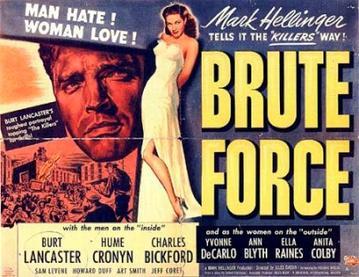


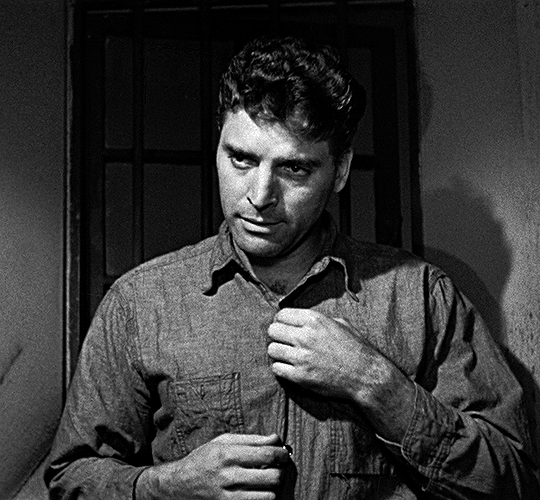
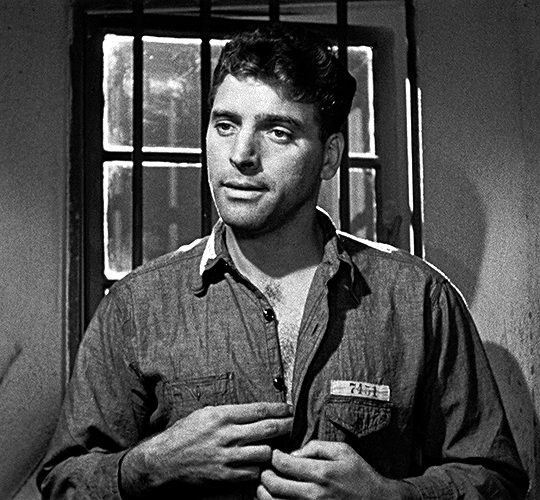
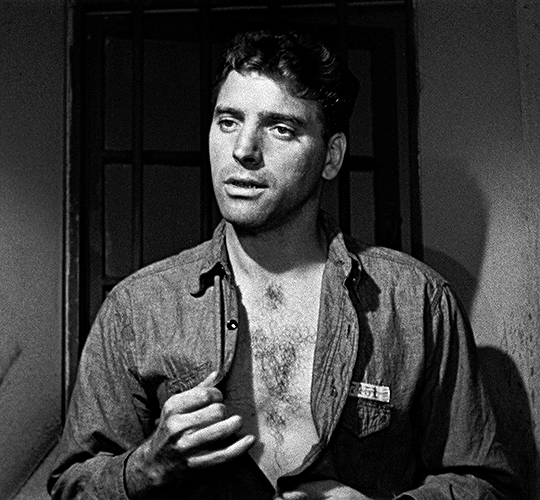
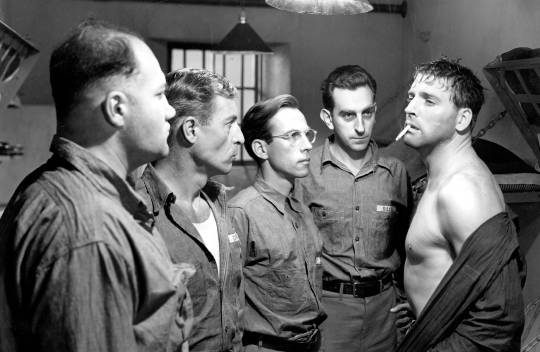
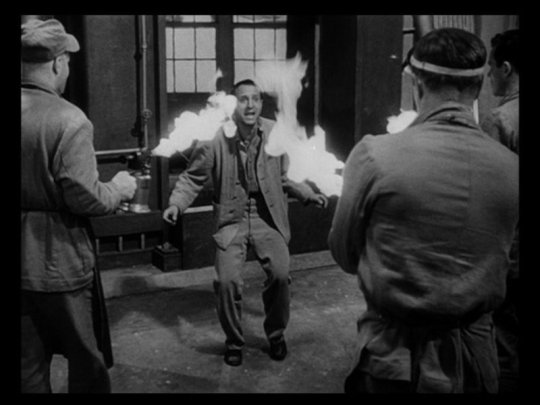
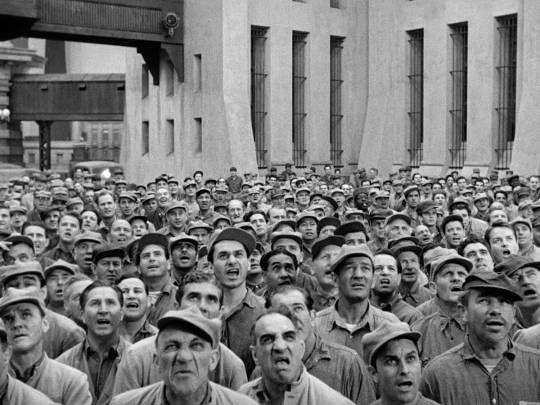

Brute Force (Jules Dassin, 1947)
Cast: Burt Lancaster, Hume Cronyn, Charles Bickford, Yvonne De Carlo, Ann Blyth, Ella Raines, Anita Colby, Sam Levene, Jeff Corey, John Hoyt, Jack Overman, Roman Bohnen, Sir Lancelot, Art Smith, Vince Barnett, Jay C. Flippen, Howard Duff. Screenplay: Richard Brooks, Robert Patterson. Cinematography: William H. Daniels. Art direction: John DeCuir, Bernard Herzbrun. Film editing: Edward Curtis. Music: Miklós Rózsa.
Surprisingly violent for a film made under the Production Code, Brute Force gives us a prison-break story in which we root for the prisoners, but it still comes down heavily on the crime-does-not-pay moral: "Nobody escapes," says one of the movie's few survivors to the camera at the end. "Nobody ever really escapes." Under Jules Dassin's direction, Richard Brooks's screenplay tries to have it both ways: The cons are heroic and the guards are villainous, but law and order must prevail. The easy way out of this is to kill off both the heroes and the villains. The chief hero is Joe Collins, played by Burt Lancaster with his usual handsomely bullish intensity. The chief villain is the head guard, Capt. Munsey, played against type by Hume Cronyn. The imbalance between the two is exhibited early in the film when Munsey tries to dress down Collins but is confronted with a massive Lancastrian cold shoulder. But Munsey has guile on his side, along with ambition to supplant the weakling Warden Barnes (Roman Bohnen), who is under political pressure to toughen up enforcement in the prison, from which reports of unrest among the inmates have been emerging. Dassin tells us all we need to know about Munsey when we see him in his office, which has little homoerotic touches in its decor like a picture of a male torso, along with a large Hitlerian photograph of Munsey himself. While beating a prisoner with a rubber hose to elicit information about a planned prison break, Munsey turns up the volume on the Wagner he is playing on the phonograph. Not that the cons are any less gentle: To punish a prisoner who collaborated with the guards, they force him into the machine that stamps out license plates, and during the climactic prison break, a stoolie is strapped to the front of a mine car and shoved out into the gunfire from the guards. The film never really lightens things up, though there are some flashback scenes involving tender moments between some of the prisoners and what the credits bill as "the women on the 'outside,'" including Ann Blyth as Collins's cancer-stricken wife. There are some good performances from Charles Bickford as the con who edits the prison newspaper and joins the escape plan after he learns that his expected parole has been put on indefinite hold, and Art Smith as the prison's cynical, alcoholic doctor, along with solid support from Sam Levene, Jeff Corey, Howard Duff, and a horde of well-chosen ugly-mug extras.
gifs from classicfilmblr
0 notes